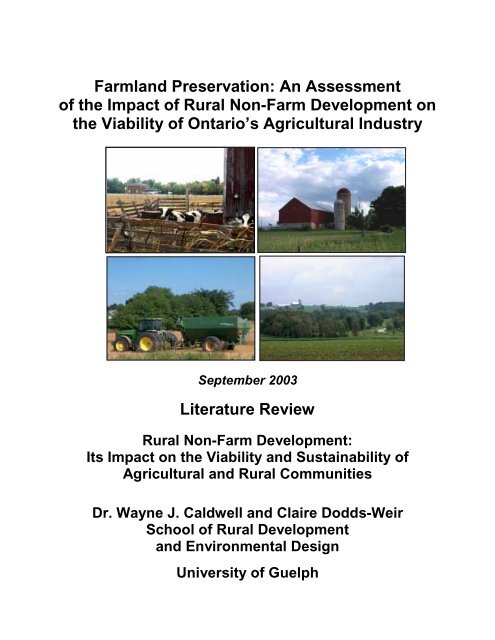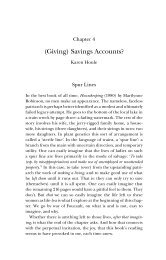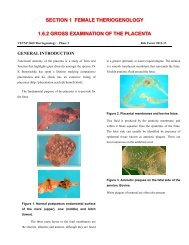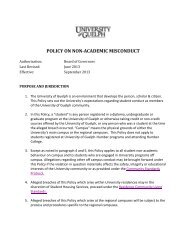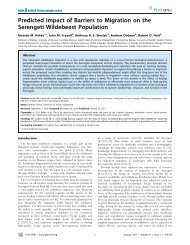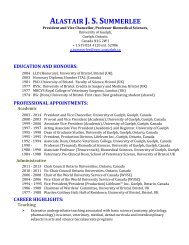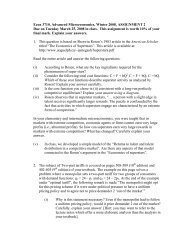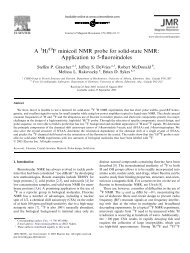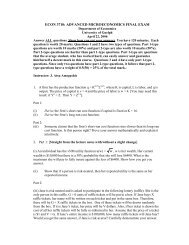An Assessment of the Impact of Rural Non-Farm Development on ...
An Assessment of the Impact of Rural Non-Farm Development on ...
An Assessment of the Impact of Rural Non-Farm Development on ...
You also want an ePaper? Increase the reach of your titles
YUMPU automatically turns print PDFs into web optimized ePapers that Google loves.
<str<strong>on</strong>g>Farm</str<strong>on</strong>g>land Preservati<strong>on</strong>: <str<strong>on</strong>g>An</str<strong>on</strong>g> <str<strong>on</strong>g>Assessment</str<strong>on</strong>g><str<strong>on</strong>g>of</str<strong>on</strong>g> <str<strong>on</strong>g>the</str<strong>on</strong>g> <str<strong>on</strong>g>Impact</str<strong>on</strong>g> <str<strong>on</strong>g>of</str<strong>on</strong>g> <str<strong>on</strong>g>Rural</str<strong>on</strong>g> <str<strong>on</strong>g>N<strong>on</strong></str<strong>on</strong>g>-<str<strong>on</strong>g>Farm</str<strong>on</strong>g> <str<strong>on</strong>g>Development</str<strong>on</strong>g> <strong>on</strong><str<strong>on</strong>g>the</str<strong>on</strong>g> Viability <str<strong>on</strong>g>of</str<strong>on</strong>g> Ontario’s Agricultural IndustrySeptember 2003Literature Review<str<strong>on</strong>g>Rural</str<strong>on</strong>g> <str<strong>on</strong>g>N<strong>on</strong></str<strong>on</strong>g>-<str<strong>on</strong>g>Farm</str<strong>on</strong>g> <str<strong>on</strong>g>Development</str<strong>on</strong>g>:Its <str<strong>on</strong>g>Impact</str<strong>on</strong>g> <strong>on</strong> <str<strong>on</strong>g>the</str<strong>on</strong>g> Viability and Sustainability <str<strong>on</strong>g>of</str<strong>on</strong>g>Agricultural and <str<strong>on</strong>g>Rural</str<strong>on</strong>g> CommunitiesDr. Wayne J. Caldwell and Claire Dodds-WeirSchool <str<strong>on</strong>g>of</str<strong>on</strong>g> <str<strong>on</strong>g>Rural</str<strong>on</strong>g> <str<strong>on</strong>g>Development</str<strong>on</strong>g>and Envir<strong>on</strong>mental DesignUniversity <str<strong>on</strong>g>of</str<strong>on</strong>g> Guelph
Overview and AcknowledgementsOverviewThis report is <str<strong>on</strong>g>the</str<strong>on</strong>g> sec<strong>on</strong>d <str<strong>on</strong>g>of</str<strong>on</strong>g> a series <str<strong>on</strong>g>of</str<strong>on</strong>g> three reports <strong>on</strong> <str<strong>on</strong>g>the</str<strong>on</strong>g> topic <str<strong>on</strong>g>of</str<strong>on</strong>g> <str<strong>on</strong>g>Rural</str<strong>on</strong>g> <str<strong>on</strong>g>N<strong>on</strong></str<strong>on</strong>g>-<str<strong>on</strong>g>Farm</str<strong>on</strong>g><str<strong>on</strong>g>Development</str<strong>on</strong>g>: and its <str<strong>on</strong>g>Impact</str<strong>on</strong>g> <strong>on</strong> Agricultural and <str<strong>on</strong>g>Rural</str<strong>on</strong>g> Communities. This reportreviews <str<strong>on</strong>g>the</str<strong>on</strong>g> literature that has documented <str<strong>on</strong>g>the</str<strong>on</strong>g> impact <str<strong>on</strong>g>of</str<strong>on</strong>g> rural n<strong>on</strong>-farm development <strong>on</strong>agricultural communities.The o<str<strong>on</strong>g>the</str<strong>on</strong>g>r two reports in <str<strong>on</strong>g>the</str<strong>on</strong>g> series are entitled:1. <str<strong>on</strong>g>Farm</str<strong>on</strong>g>land Preservati<strong>on</strong>: <str<strong>on</strong>g>An</str<strong>on</strong>g> <str<strong>on</strong>g>Assessment</str<strong>on</strong>g> <str<strong>on</strong>g>of</str<strong>on</strong>g> <str<strong>on</strong>g>the</str<strong>on</strong>g> <str<strong>on</strong>g>Impact</str<strong>on</strong>g> <str<strong>on</strong>g>of</str<strong>on</strong>g> <str<strong>on</strong>g>Rural</str<strong>on</strong>g> <str<strong>on</strong>g>N<strong>on</strong></str<strong>on</strong>g>-<str<strong>on</strong>g>Farm</str<strong>on</strong>g><str<strong>on</strong>g>Development</str<strong>on</strong>g> <strong>on</strong> <str<strong>on</strong>g>the</str<strong>on</strong>g> Viability <str<strong>on</strong>g>of</str<strong>on</strong>g> Ontario’s Agricultural Industry – PHASE IIREPORT. Written by Dr. Wayne Caldwell and Claire Dodds-Weir. 2003.2. Ontario’s Countryside: A Resource to Preserve or an Urban Area in Waiting? AReview <str<strong>on</strong>g>of</str<strong>on</strong>g> Severance Activity in Ontario’s Agricultural Land During <str<strong>on</strong>g>the</str<strong>on</strong>g> 1990s.Written by Dr. Wayne Caldwell and Claire Weir. 2002.All three reports are products <str<strong>on</strong>g>of</str<strong>on</strong>g> a research project called <str<strong>on</strong>g>Rural</str<strong>on</strong>g> <str<strong>on</strong>g>N<strong>on</strong></str<strong>on</strong>g>-<str<strong>on</strong>g>Farm</str<strong>on</strong>g> <str<strong>on</strong>g>Development</str<strong>on</strong>g>- Its <str<strong>on</strong>g>Impact</str<strong>on</strong>g> <strong>on</strong> <str<strong>on</strong>g>the</str<strong>on</strong>g> Viability and Sustainability <str<strong>on</strong>g>of</str<strong>on</strong>g> Agricultural and <str<strong>on</strong>g>Rural</str<strong>on</strong>g> Communities.All three reports are available <strong>on</strong> <str<strong>on</strong>g>the</str<strong>on</strong>g> following website:www.waynecaldwell.caAcknowledgementsThis research was made possible with:! <str<strong>on</strong>g>the</str<strong>on</strong>g> financial assistance <str<strong>on</strong>g>of</str<strong>on</strong>g> <str<strong>on</strong>g>the</str<strong>on</strong>g> Ontario Ministry <str<strong>on</strong>g>of</str<strong>on</strong>g> Agriculture and Food;! a research advisory committee, made up <str<strong>on</strong>g>of</str<strong>on</strong>g> pr<str<strong>on</strong>g>of</str<strong>on</strong>g>essi<strong>on</strong>al planners, provincialcommodity groups and staff from <str<strong>on</strong>g>the</str<strong>on</strong>g> Ontario Ministry <str<strong>on</strong>g>of</str<strong>on</strong>g> Agriculture and Food;and! <str<strong>on</strong>g>the</str<strong>on</strong>g> assistance <str<strong>on</strong>g>of</str<strong>on</strong>g> planning directors, planners, land divisi<strong>on</strong> secretaries and staffat each <str<strong>on</strong>g>of</str<strong>on</strong>g> <str<strong>on</strong>g>the</str<strong>on</strong>g> thirty four counties and regi<strong>on</strong>s in Ontario included in this study.i
Table Of C<strong>on</strong>tents1.1 Introducti<strong>on</strong>..........................................................................1.2 Significance and <str<strong>on</strong>g>Development</str<strong>on</strong>g> <str<strong>on</strong>g>of</str<strong>on</strong>g> Ontario’s Agricultural Industry ............31.2.1 Significance <str<strong>on</strong>g>of</str<strong>on</strong>g> Ontario’s Agricultural Industry............................................ 31.2.2 <str<strong>on</strong>g>Development</str<strong>on</strong>g> <str<strong>on</strong>g>of</str<strong>on</strong>g> <str<strong>on</strong>g>the</str<strong>on</strong>g> Agricultural Industry in Ontario................................... 41.3 Loss <str<strong>on</strong>g>of</str<strong>on</strong>g> Agricultural Land...............................................................1.4 Protecti<strong>on</strong> <str<strong>on</strong>g>of</str<strong>on</strong>g> Ontario’s Agricultural Resource........................................... 111.5 <str<strong>on</strong>g>Impact</str<strong>on</strong>g> <str<strong>on</strong>g>of</str<strong>on</strong>g> <str<strong>on</strong>g>Rural</str<strong>on</strong>g> <str<strong>on</strong>g>N<strong>on</strong></str<strong>on</strong>g>-<str<strong>on</strong>g>Farm</str<strong>on</strong>g> <str<strong>on</strong>g>Development</str<strong>on</strong>g> in Agricultural Land ..................151.5.1 Additi<strong>on</strong>al Costs....................................................................................... 161.5.2 Restricti<strong>on</strong>s that Accompany <str<strong>on</strong>g>Rural</str<strong>on</strong>g> <str<strong>on</strong>g>N<strong>on</strong></str<strong>on</strong>g>-<str<strong>on</strong>g>Farm</str<strong>on</strong>g> <str<strong>on</strong>g>Development</str<strong>on</strong>g>................... 171.5.3 Fragmentati<strong>on</strong> <str<strong>on</strong>g>of</str<strong>on</strong>g> <str<strong>on</strong>g>the</str<strong>on</strong>g> Agricultural Land Base........................................... 181.5.4 Cost <str<strong>on</strong>g>of</str<strong>on</strong>g> Servicing <str<strong>on</strong>g>Rural</str<strong>on</strong>g> <str<strong>on</strong>g>N<strong>on</strong></str<strong>on</strong>g>-<str<strong>on</strong>g>Farm</str<strong>on</strong>g> <str<strong>on</strong>g>Development</str<strong>on</strong>g> ..................................... 191.5.5 Change in <str<strong>on</strong>g>Rural</str<strong>on</strong>g> Demographic................................................................. 201.6 Creati<strong>on</strong> <str<strong>on</strong>g>of</str<strong>on</strong>g> <str<strong>on</strong>g>Rural</str<strong>on</strong>g> <str<strong>on</strong>g>N<strong>on</strong></str<strong>on</strong>g>-<str<strong>on</strong>g>Farm</str<strong>on</strong>g> Lots in Ontario’s Countryside ......................231.7 Role <str<strong>on</strong>g>of</str<strong>on</strong>g> Land-use Planning...............................................................1.7.1 <str<strong>on</strong>g>Rural</str<strong>on</strong>g> <str<strong>on</strong>g>Development</str<strong>on</strong>g> Through <str<strong>on</strong>g>the</str<strong>on</strong>g> Severance Process.............................. 271.7.2 Current Land Divisi<strong>on</strong> Process in Ontario................................................ 281.7.3 Planning for Agriculture in Ontario Throughout <str<strong>on</strong>g>the</str<strong>on</strong>g> 1990s ....................... 291.8 C<strong>on</strong>clusi<strong>on</strong>............................................................................ii
List <str<strong>on</strong>g>of</str<strong>on</strong>g> FiguresFigurePage1.1 <str<strong>on</strong>g>Farm</str<strong>on</strong>g> Cash Receipts by Province, Canada, 2001 31.2 <str<strong>on</strong>g>Farm</str<strong>on</strong>g> Cash Receipts by Commodity, Ontario, 2001 41.3 Fewer Census <str<strong>on</strong>g>Farm</str<strong>on</strong>g>s and More Larger <str<strong>on</strong>g>Farm</str<strong>on</strong>g>s between1981 and 19961.4 Percentage <str<strong>on</strong>g>of</str<strong>on</strong>g> Provincial Class 1 Soil C<strong>on</strong>sumed forUrban Purposes5101.5 The <str<strong>on</strong>g>Impact</str<strong>on</strong>g> <str<strong>on</strong>g>of</str<strong>on</strong>g> Scattered versus Clustered <str<strong>on</strong>g>Development</str<strong>on</strong>g> 171.6 Median Cost <str<strong>on</strong>g>of</str<strong>on</strong>g> Community Services per Dollar <str<strong>on</strong>g>of</str<strong>on</strong>g>Revenue Raised1.7 <str<strong>on</strong>g>Rural</str<strong>on</strong>g> <str<strong>on</strong>g>N<strong>on</strong></str<strong>on</strong>g>-<str<strong>on</strong>g>Farm</str<strong>on</strong>g> vs. <str<strong>on</strong>g>Rural</str<strong>on</strong>g> <str<strong>on</strong>g>Farm</str<strong>on</strong>g> Populati<strong>on</strong> in OntarioSince 195620211.8 The Current Land Divisi<strong>on</strong> Process in Ontario 29iii
List <str<strong>on</strong>g>of</str<strong>on</strong>g> TablesTablePage1.1 Nati<strong>on</strong>al Agricultural Land Supply by Capability Rating 8iv
<str<strong>on</strong>g>Impact</str<strong>on</strong>g> <str<strong>on</strong>g>of</str<strong>on</strong>g> <str<strong>on</strong>g>Rural</str<strong>on</strong>g> <str<strong>on</strong>g>N<strong>on</strong></str<strong>on</strong>g>-<str<strong>on</strong>g>Farm</str<strong>on</strong>g> <str<strong>on</strong>g>Development</str<strong>on</strong>g> <strong>on</strong> <str<strong>on</strong>g>the</str<strong>on</strong>g> Viability <str<strong>on</strong>g>of</str<strong>on</strong>g> Agriculture: Literature Review1.1 Introducti<strong>on</strong>Ontario is blessed with some <str<strong>on</strong>g>of</str<strong>on</strong>g> <str<strong>on</strong>g>the</str<strong>on</strong>g> best farmland in Canada. Agricultural land is<strong>on</strong>e <str<strong>on</strong>g>of</str<strong>on</strong>g> Ontario’s most important resources. Literature identifies that as urbanboundaries c<strong>on</strong>tinue to expand and as rural n<strong>on</strong>-farm development increases in <str<strong>on</strong>g>the</str<strong>on</strong>g>countryside, Ontario’s agricultural resource becomes increasingly scarce, and <str<strong>on</strong>g>the</str<strong>on</strong>g>viability <str<strong>on</strong>g>of</str<strong>on</strong>g> <str<strong>on</strong>g>the</str<strong>on</strong>g> agricultural industry it supports becomes increasingly challenged.TheNew Webster’s English Dicti<strong>on</strong>ary defines viable as “possessing <str<strong>on</strong>g>the</str<strong>on</strong>g> ability to grow anddevelop”. While <str<strong>on</strong>g>the</str<strong>on</strong>g> viability <str<strong>on</strong>g>of</str<strong>on</strong>g> <str<strong>on</strong>g>the</str<strong>on</strong>g> agricultural industry is an incredibly complex issue,influenced by nati<strong>on</strong>al and internati<strong>on</strong>al laws regulati<strong>on</strong>s and markets, it has beenrecognized that development that occurs in proximity to agriculture also has an impact<strong>on</strong> <str<strong>on</strong>g>the</str<strong>on</strong>g> viability <str<strong>on</strong>g>of</str<strong>on</strong>g> agriculture.While <str<strong>on</strong>g>the</str<strong>on</strong>g>re are a number <str<strong>on</strong>g>of</str<strong>on</strong>g> perspectives <strong>on</strong> <str<strong>on</strong>g>the</str<strong>on</strong>g> specific impacts <str<strong>on</strong>g>of</str<strong>on</strong>g> rural n<strong>on</strong>farmdevelopment <strong>on</strong> <str<strong>on</strong>g>the</str<strong>on</strong>g> agricultural industry, <str<strong>on</strong>g>the</str<strong>on</strong>g> majority <str<strong>on</strong>g>of</str<strong>on</strong>g> authors who have written<strong>on</strong> <str<strong>on</strong>g>the</str<strong>on</strong>g> subject agree that <str<strong>on</strong>g>the</str<strong>on</strong>g>re is some impact as a result <str<strong>on</strong>g>of</str<strong>on</strong>g> n<strong>on</strong>-farm developmentestablishing in an agricultural area. In his review <str<strong>on</strong>g>of</str<strong>on</strong>g> evoluti<strong>on</strong> <str<strong>on</strong>g>of</str<strong>on</strong>g> agricultural landpreservati<strong>on</strong> in Ontario and specifically in Hur<strong>on</strong> County, Caldwell (1995) identified that<str<strong>on</strong>g>the</str<strong>on</strong>g> l<strong>on</strong>g-term welfare <str<strong>on</strong>g>of</str<strong>on</strong>g> many rural communities is dependent up<strong>on</strong> <str<strong>on</strong>g>the</str<strong>on</strong>g> preservati<strong>on</strong> <str<strong>on</strong>g>of</str<strong>on</strong>g><str<strong>on</strong>g>the</str<strong>on</strong>g> agricultural land resource. Caldwell also stated that “not <strong>on</strong>ly is <str<strong>on</strong>g>the</str<strong>on</strong>g> physical loss <str<strong>on</strong>g>of</str<strong>on</strong>g>farmland a threat to an active agricultural industry, but so too are <str<strong>on</strong>g>the</str<strong>on</strong>g> restricti<strong>on</strong>s thattend to accompany <str<strong>on</strong>g>the</str<strong>on</strong>g> gradual introducti<strong>on</strong> <str<strong>on</strong>g>of</str<strong>on</strong>g> n<strong>on</strong>-farm uses in agricultural areas”(1995, p.22). This c<strong>on</strong>clusi<strong>on</strong> is reflected in <str<strong>on</strong>g>the</str<strong>on</strong>g> literature that discusses <str<strong>on</strong>g>the</str<strong>on</strong>g> impact <str<strong>on</strong>g>of</str<strong>on</strong>g>n<strong>on</strong>-farm development <strong>on</strong> <str<strong>on</strong>g>the</str<strong>on</strong>g> agricultural industry.- 1 -
<str<strong>on</strong>g>Impact</str<strong>on</strong>g> <str<strong>on</strong>g>of</str<strong>on</strong>g> <str<strong>on</strong>g>Rural</str<strong>on</strong>g> <str<strong>on</strong>g>N<strong>on</strong></str<strong>on</strong>g>-<str<strong>on</strong>g>Farm</str<strong>on</strong>g> <str<strong>on</strong>g>Development</str<strong>on</strong>g> <strong>on</strong> <str<strong>on</strong>g>the</str<strong>on</strong>g> Viability <str<strong>on</strong>g>of</str<strong>on</strong>g> Agriculture: Literature ReviewThe goal <str<strong>on</strong>g>of</str<strong>on</strong>g> this report is to explore some <str<strong>on</strong>g>of</str<strong>on</strong>g> <str<strong>on</strong>g>the</str<strong>on</strong>g> literature and research thatinforms <str<strong>on</strong>g>the</str<strong>on</strong>g> discussi<strong>on</strong> <strong>on</strong> <str<strong>on</strong>g>the</str<strong>on</strong>g> impact <str<strong>on</strong>g>of</str<strong>on</strong>g> rural n<strong>on</strong>-farm development <strong>on</strong> <str<strong>on</strong>g>the</str<strong>on</strong>g> viability <str<strong>on</strong>g>of</str<strong>on</strong>g>Ontario’s agricultural industry. The first secti<strong>on</strong> <str<strong>on</strong>g>of</str<strong>on</strong>g> this report will address <str<strong>on</strong>g>the</str<strong>on</strong>g>significance <str<strong>on</strong>g>of</str<strong>on</strong>g> <str<strong>on</strong>g>the</str<strong>on</strong>g> agricultural industry and its development in Ontario. Next, <str<strong>on</strong>g>the</str<strong>on</strong>g>literature <strong>on</strong> <str<strong>on</strong>g>the</str<strong>on</strong>g> physical impact <str<strong>on</strong>g>of</str<strong>on</strong>g> rural n<strong>on</strong>-farm development is summarized. Thethird secti<strong>on</strong> will look at <str<strong>on</strong>g>the</str<strong>on</strong>g> agricultural land preservati<strong>on</strong> effort. Fourthly, existingliterature that has attempted to identify <str<strong>on</strong>g>the</str<strong>on</strong>g> impact <str<strong>on</strong>g>of</str<strong>on</strong>g> rural n<strong>on</strong>-farm development <strong>on</strong>agriculture is reviewed. The next secti<strong>on</strong> will discuss why <str<strong>on</strong>g>the</str<strong>on</strong>g> creati<strong>on</strong> <str<strong>on</strong>g>of</str<strong>on</strong>g> rural n<strong>on</strong>-farmdevelopment is so persistent. The final secti<strong>on</strong> reviews <str<strong>on</strong>g>the</str<strong>on</strong>g> historical role <str<strong>on</strong>g>of</str<strong>on</strong>g> planningand planning policy with regard to <str<strong>on</strong>g>the</str<strong>on</strong>g> development <str<strong>on</strong>g>of</str<strong>on</strong>g> rural n<strong>on</strong>-farm lots in <str<strong>on</strong>g>the</str<strong>on</strong>g>province.- 2 -
<str<strong>on</strong>g>Impact</str<strong>on</strong>g> <str<strong>on</strong>g>of</str<strong>on</strong>g> <str<strong>on</strong>g>Rural</str<strong>on</strong>g> <str<strong>on</strong>g>N<strong>on</strong></str<strong>on</strong>g>-<str<strong>on</strong>g>Farm</str<strong>on</strong>g> <str<strong>on</strong>g>Development</str<strong>on</strong>g> <strong>on</strong> <str<strong>on</strong>g>the</str<strong>on</strong>g> Viability <str<strong>on</strong>g>of</str<strong>on</strong>g> Agriculture: Literature Review1.2 Significance and <str<strong>on</strong>g>Development</str<strong>on</strong>g> <str<strong>on</strong>g>of</str<strong>on</strong>g> Ontario’s AgriculturalIndustry1.2.1 Significance <str<strong>on</strong>g>of</str<strong>on</strong>g> Ontario’s Agricultural IndustryDespite tremendous changes in <str<strong>on</strong>g>the</str<strong>on</strong>g> twentieth century in terms <str<strong>on</strong>g>of</str<strong>on</strong>g> ec<strong>on</strong>omicdevelopment and urbanizati<strong>on</strong>, agriculture remains a critical element in our daily lives inOntario (Bryant, Russworm and McLellan, 1982; Bryant and Johnst<strong>on</strong>, 1992).Theagricultural industry in Ontario is significant at both <str<strong>on</strong>g>the</str<strong>on</strong>g> nati<strong>on</strong>al and provincial levels.Figure 1.1 illustrates that Ontario led all provinces in farm cash receipts in 2000, withapproximately 24% <str<strong>on</strong>g>of</str<strong>on</strong>g> <str<strong>on</strong>g>the</str<strong>on</strong>g> nati<strong>on</strong>al total (Statistics Canada, 2001b). Ontario alsoaccounted for 24% <str<strong>on</strong>g>of</str<strong>on</strong>g> <str<strong>on</strong>g>the</str<strong>on</strong>g> nati<strong>on</strong>’s farms in 2000 (Statistics Canada, 2001b).Figure 1.1 <str<strong>on</strong>g>Farm</str<strong>on</strong>g> Cash Receipts by Province, Canada, 2001Source: Statistics Canada, 2001c, Catalogue No. 21-603.Ontario is an ec<strong>on</strong>omic powerhouse within Canadian agriculture, with its totalgross farm receipts totalling just over $9.1 billi<strong>on</strong> in 2000 (Statistics Canada, 2001b).- 3 -
<str<strong>on</strong>g>Impact</str<strong>on</strong>g> <str<strong>on</strong>g>of</str<strong>on</strong>g> <str<strong>on</strong>g>Rural</str<strong>on</strong>g> <str<strong>on</strong>g>N<strong>on</strong></str<strong>on</strong>g>-<str<strong>on</strong>g>Farm</str<strong>on</strong>g> <str<strong>on</strong>g>Development</str<strong>on</strong>g> <strong>on</strong> <str<strong>on</strong>g>the</str<strong>on</strong>g> Viability <str<strong>on</strong>g>of</str<strong>on</strong>g> Agriculture: Literature ReviewThe agricultural industry in Ontario is diverse. Figure 1.2 illustrates <str<strong>on</strong>g>the</str<strong>on</strong>g> majorcommodity groups by farm cash receipts. The livestock sector accounts for almost 50%<str<strong>on</strong>g>of</str<strong>on</strong>g> Ontario’s farm receipts, making it <str<strong>on</strong>g>the</str<strong>on</strong>g> most ec<strong>on</strong>omically significant comp<strong>on</strong>ent <str<strong>on</strong>g>of</str<strong>on</strong>g>Ontario’s agricultural industry in 2001. The cash crop sector, <str<strong>on</strong>g>the</str<strong>on</strong>g> flower, nursery and<str<strong>on</strong>g>the</str<strong>on</strong>g> fruit and vegetable sectors each comprise about 10% <str<strong>on</strong>g>of</str<strong>on</strong>g> <str<strong>on</strong>g>the</str<strong>on</strong>g> farm cash receipts in2001.Figure 1.2 <str<strong>on</strong>g>Farm</str<strong>on</strong>g> Cash Receipts by Commodity, Ontario, 2001Source: Statistics Canada, 2001c, Catalogue No. 21-603.1.2.2 <str<strong>on</strong>g>Development</str<strong>on</strong>g> <str<strong>on</strong>g>of</str<strong>on</strong>g> <str<strong>on</strong>g>the</str<strong>on</strong>g> Agricultural Industry in OntarioDespite <str<strong>on</strong>g>the</str<strong>on</strong>g> apparent prosperity that has been generated by <str<strong>on</strong>g>the</str<strong>on</strong>g> agriculturalindustry, some individuals and entire commodities are under pressure; virtually everysector is facing <str<strong>on</strong>g>the</str<strong>on</strong>g> challenge <str<strong>on</strong>g>of</str<strong>on</strong>g> rapid change. Over <str<strong>on</strong>g>the</str<strong>on</strong>g> past few decades Ontario hasseen a number <str<strong>on</strong>g>of</str<strong>on</strong>g> trends that indicate significant changes in <str<strong>on</strong>g>the</str<strong>on</strong>g> agricultural industry.The number <str<strong>on</strong>g>of</str<strong>on</strong>g> farms in Ontario has declined from 68,633 in 1991 to 59,728 in 2001- 4 -
<str<strong>on</strong>g>Impact</str<strong>on</strong>g> <str<strong>on</strong>g>of</str<strong>on</strong>g> <str<strong>on</strong>g>Rural</str<strong>on</strong>g> <str<strong>on</strong>g>N<strong>on</strong></str<strong>on</strong>g>-<str<strong>on</strong>g>Farm</str<strong>on</strong>g> <str<strong>on</strong>g>Development</str<strong>on</strong>g> <strong>on</strong> <str<strong>on</strong>g>the</str<strong>on</strong>g> Viability <str<strong>on</strong>g>of</str<strong>on</strong>g> Agriculture: Literature Review(Statistics Canada, 2001b). While <str<strong>on</strong>g>the</str<strong>on</strong>g>re is an overall trend that indicates <str<strong>on</strong>g>the</str<strong>on</strong>g> number <str<strong>on</strong>g>of</str<strong>on</strong>g>farms in Ontario has been declining, <str<strong>on</strong>g>the</str<strong>on</strong>g> size in terms <str<strong>on</strong>g>of</str<strong>on</strong>g> area, herd sizes and grossfarm receipts have been increasing. The average Ontario farm was 226 acres in 2001,up 9.7% from 1996 (Statistics Canada, 2001b). Figure 1.3 illustrates this trend bycomparing <str<strong>on</strong>g>the</str<strong>on</strong>g> number <str<strong>on</strong>g>of</str<strong>on</strong>g> census farms with <str<strong>on</strong>g>the</str<strong>on</strong>g> number <str<strong>on</strong>g>of</str<strong>on</strong>g> farms reporting a grossrevenue <str<strong>on</strong>g>of</str<strong>on</strong>g> $100,000 and over.Figure 1.3 Fewer Census <str<strong>on</strong>g>Farm</str<strong>on</strong>g>s, More Larger <str<strong>on</strong>g>Farm</str<strong>on</strong>g>s between 1981 and 199690,000Fewer census-farms, more larger farms,Ontario80,000Number <str<strong>on</strong>g>of</str<strong>on</strong>g> census-farms70,00060,00050,00040,00030,00020,000farms with gross revenue <str<strong>on</strong>g>of</str<strong>on</strong>g> $100,000 and over (1995 c<strong>on</strong>stant dollars)All census-farms (holdings with some products for sale)10,00001981 1986 1981 1996Source: Statistics Canada, Census <str<strong>on</strong>g>of</str<strong>on</strong>g> Agriculture. 1981 to 1996There are many reas<strong>on</strong>s why <str<strong>on</strong>g>the</str<strong>on</strong>g>se changes in <str<strong>on</strong>g>the</str<strong>on</strong>g> agricultural industry have,and c<strong>on</strong>tinue to occur. According to a report published by Agricultural Odyssey Groupin 2002, <str<strong>on</strong>g>the</str<strong>on</strong>g>se changes have been brought <strong>on</strong>, in part, by internati<strong>on</strong>al tradeliberalizati<strong>on</strong>,c<strong>on</strong>sumer demands, growing envir<strong>on</strong>mental c<strong>on</strong>cerns, a rati<strong>on</strong>alizati<strong>on</strong> <str<strong>on</strong>g>of</str<strong>on</strong>g>- 5 -
<str<strong>on</strong>g>Impact</str<strong>on</strong>g> <str<strong>on</strong>g>of</str<strong>on</strong>g> <str<strong>on</strong>g>Rural</str<strong>on</strong>g> <str<strong>on</strong>g>N<strong>on</strong></str<strong>on</strong>g>-<str<strong>on</strong>g>Farm</str<strong>on</strong>g> <str<strong>on</strong>g>Development</str<strong>on</strong>g> <strong>on</strong> <str<strong>on</strong>g>the</str<strong>on</strong>g> Viability <str<strong>on</strong>g>of</str<strong>on</strong>g> Agriculture: Literature Reviewsuppliers and processors, shrinking government commitment to <str<strong>on</strong>g>the</str<strong>on</strong>g> sector as well as<str<strong>on</strong>g>the</str<strong>on</strong>g> use <str<strong>on</strong>g>of</str<strong>on</strong>g> science and communicati<strong>on</strong> technologies that were not imagined agenerati<strong>on</strong> ago” (Agricultural Odyssey Group, 2002, p.5).Increased technology such as mechanizati<strong>on</strong>, computerizati<strong>on</strong>, and biotechnology,has played a central part in <str<strong>on</strong>g>the</str<strong>on</strong>g> development <str<strong>on</strong>g>of</str<strong>on</strong>g> <str<strong>on</strong>g>the</str<strong>on</strong>g> agricultural industry. This increasein technology has allowed farms to raise more livestock with less labour and to obtainincreased crop yields. As labour requirements in agriculture have declined drastically,<str<strong>on</strong>g>the</str<strong>on</strong>g> industry has become ec<strong>on</strong>omically rati<strong>on</strong>alized, dividing <str<strong>on</strong>g>the</str<strong>on</strong>g> industry into fewer,larger units and has shifted from labour to capital intensity (Trought<strong>on</strong>, 1990, p.24).This trend has partially driven <str<strong>on</strong>g>the</str<strong>on</strong>g> shift in agriculture towards large livestock facilities.Increasingly farmers are forced to compete in <str<strong>on</strong>g>the</str<strong>on</strong>g> global market. As barriers totrade are removed, farmers are forced to compete internati<strong>on</strong>ally. In resp<strong>on</strong>se, farmerscompete for larger porti<strong>on</strong>s <str<strong>on</strong>g>of</str<strong>on</strong>g> limited producti<strong>on</strong> under cost-price squeeze 1 c<strong>on</strong>diti<strong>on</strong>s(Caldwell 2001). Success is measured in terms <str<strong>on</strong>g>of</str<strong>on</strong>g> cost-per-unit <str<strong>on</strong>g>of</str<strong>on</strong>g> producti<strong>on</strong> andproducti<strong>on</strong> efficiency is seen as stemming from increased scale <str<strong>on</strong>g>of</str<strong>on</strong>g> operati<strong>on</strong>, capitalintensificati<strong>on</strong>, and reliance <strong>on</strong> sec<strong>on</strong>dary inputs (Trought<strong>on</strong>, 1990, p.23). In order tomake a pr<str<strong>on</strong>g>of</str<strong>on</strong>g>it, farmers feel pressure to grow larger. “In a search for increasingefficiencies and in resp<strong>on</strong>se to <str<strong>on</strong>g>the</str<strong>on</strong>g> cost price squeeze, farmers find that net returns perunit <str<strong>on</strong>g>of</str<strong>on</strong>g> producti<strong>on</strong> are decreasing – dictating larger, more specialized and more efficientoperati<strong>on</strong>s” (Caldwell, 2001, p.3). As a result, family farmers <str<strong>on</strong>g>of</str<strong>on</strong>g>ten find <str<strong>on</strong>g>the</str<strong>on</strong>g>mselvesworking with large corporati<strong>on</strong>s to develop vertically integrated networks, where <str<strong>on</strong>g>the</str<strong>on</strong>g>corporati<strong>on</strong> provides <str<strong>on</strong>g>the</str<strong>on</strong>g> farmer with funding to build a new barn and to produce1 The cost price squeeze is a crisis in farming because <str<strong>on</strong>g>the</str<strong>on</strong>g> price that farmers are paid is low but <str<strong>on</strong>g>the</str<strong>on</strong>g> cost <str<strong>on</strong>g>of</str<strong>on</strong>g>producti<strong>on</strong> keeps going up.- 6 -
<str<strong>on</strong>g>Impact</str<strong>on</strong>g> <str<strong>on</strong>g>of</str<strong>on</strong>g> <str<strong>on</strong>g>Rural</str<strong>on</strong>g> <str<strong>on</strong>g>N<strong>on</strong></str<strong>on</strong>g>-<str<strong>on</strong>g>Farm</str<strong>on</strong>g> <str<strong>on</strong>g>Development</str<strong>on</strong>g> <strong>on</strong> <str<strong>on</strong>g>the</str<strong>on</strong>g> Viability <str<strong>on</strong>g>of</str<strong>on</strong>g> Agriculture: Literature Reviewlivestock <strong>on</strong> a c<strong>on</strong>tract basis. The farmer is increasingly financially c<strong>on</strong>nected to <str<strong>on</strong>g>the</str<strong>on</strong>g>corporati<strong>on</strong> and less c<strong>on</strong>nected with <str<strong>on</strong>g>the</str<strong>on</strong>g> rural community.As discussed above, <str<strong>on</strong>g>the</str<strong>on</strong>g>re are numerous demands and challenges that pressureOntario’s agricultural industry. <str<strong>on</strong>g>Farm</str<strong>on</strong>g>ers must remain as flexible as possible in order toresp<strong>on</strong>d to <str<strong>on</strong>g>the</str<strong>on</strong>g>se demands. As n<strong>on</strong>-farm development is established, <str<strong>on</strong>g>the</str<strong>on</strong>g> ability <str<strong>on</strong>g>of</str<strong>on</strong>g> <str<strong>on</strong>g>the</str<strong>on</strong>g>producer to remain flexible is challenged.- 7 -
<str<strong>on</strong>g>Impact</str<strong>on</strong>g> <str<strong>on</strong>g>of</str<strong>on</strong>g> <str<strong>on</strong>g>Rural</str<strong>on</strong>g> <str<strong>on</strong>g>N<strong>on</strong></str<strong>on</strong>g>-<str<strong>on</strong>g>Farm</str<strong>on</strong>g> <str<strong>on</strong>g>Development</str<strong>on</strong>g> <strong>on</strong> <str<strong>on</strong>g>the</str<strong>on</strong>g> Viability <str<strong>on</strong>g>of</str<strong>on</strong>g> Agriculture: Literature Review1.3 Loss <str<strong>on</strong>g>of</str<strong>on</strong>g> Agricultural LandIn Canada, approximately 673,000 square kilometres <str<strong>on</strong>g>of</str<strong>on</strong>g> land are used foragriculture. Although this figure seems large, it represents <strong>on</strong>ly about 7 percent <str<strong>on</strong>g>of</str<strong>on</strong>g>Canada’s total landmass (Statistics Canada, 2001 c). Not all <str<strong>on</strong>g>the</str<strong>on</strong>g> land-used foragriculture is c<strong>on</strong>sidered high-capability. Despite Canada’s size, dependable 2agricultural land is a scarce resource. Agricultural land in Canada has been classifiedaccording to its limitati<strong>on</strong>s for producti<strong>on</strong> based <strong>on</strong> variables such as soil and climate.Table 1.1 illustrates <str<strong>on</strong>g>the</str<strong>on</strong>g> percentage <str<strong>on</strong>g>of</str<strong>on</strong>g> Canada’s land area that is c<strong>on</strong>sidered Class 1 to3. This table dem<strong>on</strong>strates that <strong>on</strong>ly about 5 percent <str<strong>on</strong>g>of</str<strong>on</strong>g> Canada’s land area isc<strong>on</strong>sidered dependable.Table 1.1Nati<strong>on</strong>al Agricultural Land Supply by Capability RatingCanadaLandInventoryClassDescripti<strong>on</strong>% OfCanada’sLand AreaRelativeProducti<strong>on</strong>Potential ForArableAgricultureRelativeDirect CostsOf Producti<strong>on</strong>Per Kg. OfProductProduced1 EXCELLENT TO 0.45% 1.00 1.00VERY GOOD2 GOOD 1.80% 0.80 1.303 FAIRLY GOOD 2.80% 0.65 1.505.05%Source: C.F. Bentley and L.A. Leskiw, “Sustainability <str<strong>on</strong>g>of</str<strong>on</strong>g> <str<strong>on</strong>g>Farm</str<strong>on</strong>g>ed Lands: Current Trends and Thinking”,Canadian Envir<strong>on</strong>mental Advisory Council, 1984, p.11 in Misek-Evans, Margaret. 1992a. BalancingGrowth with Agriculture: Approaches to Managing <str<strong>on</strong>g>N<strong>on</strong></str<strong>on</strong>g>-<str<strong>on</strong>g>Farm</str<strong>on</strong>g> <str<strong>on</strong>g>Rural</str<strong>on</strong>g> Residential <str<strong>on</strong>g>Development</str<strong>on</strong>g>. Department<str<strong>on</strong>g>of</str<strong>on</strong>g> Planning and <str<strong>on</strong>g>Development</str<strong>on</strong>g>, County <str<strong>on</strong>g>of</str<strong>on</strong>g> Oxford, p.3.Ontario’s countryside is made up <str<strong>on</strong>g>of</str<strong>on</strong>g> some <str<strong>on</strong>g>of</str<strong>on</strong>g> <str<strong>on</strong>g>the</str<strong>on</strong>g> best farmland in Canada.Numbers recently published by Statistics Canada’s Envir<strong>on</strong>ment Accounts and- 8 -
<str<strong>on</strong>g>Impact</str<strong>on</strong>g> <str<strong>on</strong>g>of</str<strong>on</strong>g> <str<strong>on</strong>g>Rural</str<strong>on</strong>g> <str<strong>on</strong>g>N<strong>on</strong></str<strong>on</strong>g>-<str<strong>on</strong>g>Farm</str<strong>on</strong>g> <str<strong>on</strong>g>Development</str<strong>on</strong>g> <strong>on</strong> <str<strong>on</strong>g>the</str<strong>on</strong>g> Viability <str<strong>on</strong>g>of</str<strong>on</strong>g> Agriculture: Literature ReviewStatistics Divisi<strong>on</strong> indicate that Ontario c<strong>on</strong>tains 52% <str<strong>on</strong>g>of</str<strong>on</strong>g> Canada’s Class 1 land, 14% <str<strong>on</strong>g>of</str<strong>on</strong>g>Canada’s Class 2 land, 11% <str<strong>on</strong>g>of</str<strong>on</strong>g> its Class 3 land and 8% <str<strong>on</strong>g>of</str<strong>on</strong>g> its Class 4 land (StatisticsCanada, 2001c). The same publicati<strong>on</strong> identified that <strong>on</strong>ly 6.8% <str<strong>on</strong>g>of</str<strong>on</strong>g> Ontario’s total landis c<strong>on</strong>sidered dependable agricultural land.These statistics identify that <str<strong>on</strong>g>the</str<strong>on</strong>g>preservati<strong>on</strong> <str<strong>on</strong>g>of</str<strong>on</strong>g> <str<strong>on</strong>g>the</str<strong>on</strong>g> agricultural resource in Ontario is critical, due to <str<strong>on</strong>g>the</str<strong>on</strong>g> lack <str<strong>on</strong>g>of</str<strong>on</strong>g> highcapabilityagricultural land within Canada.In 1977, <str<strong>on</strong>g>the</str<strong>on</strong>g> Canada Land Inventory established that a total <str<strong>on</strong>g>of</str<strong>on</strong>g> 16.3 milli<strong>on</strong> acresin Ontario is potentially suitable for arable agriculture (Ontario Soil C<strong>on</strong>servati<strong>on</strong>Society, 1977, p.5). About 3.5 milli<strong>on</strong> acres are north <str<strong>on</strong>g>of</str<strong>on</strong>g> North Bay where climacticlimitati<strong>on</strong>s tend to restrict agricultural development. The remaining 12.8 milli<strong>on</strong> acresare south <str<strong>on</strong>g>of</str<strong>on</strong>g> <str<strong>on</strong>g>the</str<strong>on</strong>g> Laurentian Shield, where most Ontario residents and <str<strong>on</strong>g>the</str<strong>on</strong>g>ir spacec<strong>on</strong>sumingactivities are located (Soil C<strong>on</strong>servati<strong>on</strong> Society <str<strong>on</strong>g>of</str<strong>on</strong>g> America. 1977, p.5).The challenge in Ontario is that, due to historic settlement patterns, most urbancentres are situated in <str<strong>on</strong>g>the</str<strong>on</strong>g> middle <str<strong>on</strong>g>of</str<strong>on</strong>g> highly-productive agricultural land. In all but a fewcases, fur<str<strong>on</strong>g>the</str<strong>on</strong>g>r outward expansi<strong>on</strong> <str<strong>on</strong>g>of</str<strong>on</strong>g> <str<strong>on</strong>g>the</str<strong>on</strong>g>se centres has little alternative but to use goodfarmland for urban uses (Soil C<strong>on</strong>servati<strong>on</strong> Society <str<strong>on</strong>g>of</str<strong>on</strong>g> America. 1977, p.5).As aresult, <str<strong>on</strong>g>the</str<strong>on</strong>g>re is a great deal <str<strong>on</strong>g>of</str<strong>on</strong>g> pressure to use agricultural land for purposes o<str<strong>on</strong>g>the</str<strong>on</strong>g>r thanagriculture. There is competiti<strong>on</strong> from residential, industrial, commercial, instituti<strong>on</strong>aland recreati<strong>on</strong>al uses, gravel pits, landfill sites, highways, and o<str<strong>on</strong>g>the</str<strong>on</strong>g>r uses (OntarioMinistry <str<strong>on</strong>g>of</str<strong>on</strong>g> Agriculture and Food, 1992, p.3). This pressure is increasing as <str<strong>on</strong>g>the</str<strong>on</strong>g>populati<strong>on</strong> <str<strong>on</strong>g>of</str<strong>on</strong>g> Ontario grows, and is predicted to grow, at rapid rates over <str<strong>on</strong>g>the</str<strong>on</strong>g> nextseveral decades.2 Dependable agricultural land is a term that is used by Statistics Canada to describe agricultural land c<strong>on</strong>sidered asClass 1 to 3 by <str<strong>on</strong>g>the</str<strong>on</strong>g> Canada Land Inventory.- 9 -
<str<strong>on</strong>g>Impact</str<strong>on</strong>g> <str<strong>on</strong>g>of</str<strong>on</strong>g> <str<strong>on</strong>g>Rural</str<strong>on</strong>g> <str<strong>on</strong>g>N<strong>on</strong></str<strong>on</strong>g>-<str<strong>on</strong>g>Farm</str<strong>on</strong>g> <str<strong>on</strong>g>Development</str<strong>on</strong>g> <strong>on</strong> <str<strong>on</strong>g>the</str<strong>on</strong>g> Viability <str<strong>on</strong>g>of</str<strong>on</strong>g> Agriculture: Literature ReviewUrban uses have c<strong>on</strong>sumed 12,000 square kilometres <str<strong>on</strong>g>of</str<strong>on</strong>g> land since 1971. Onehalf <str<strong>on</strong>g>of</str<strong>on</strong>g> this was “dependable” farmland (i.e. Class 1-2-3 land as classified by <str<strong>on</strong>g>the</str<strong>on</strong>g> CanadaLand Inventory) (Statistics Canada, 2001 c).Figure 1.4 illustrates as <str<strong>on</strong>g>of</str<strong>on</strong>g> 1996, over18% <str<strong>on</strong>g>of</str<strong>on</strong>g> Ontario’s Class 1 farmland was being used for urban purposes. This land is, forall intents and purposes, permanently lost to agriculture (Statistics Canada, 2001 c).Figure 1.420Percentage <str<strong>on</strong>g>of</str<strong>on</strong>g> Provincial Class 1 Soil C<strong>on</strong>sumed for Urban PurposesPercent <str<strong>on</strong>g>of</str<strong>on</strong>g> Class 1 land occupied by urban land1816141210864201971 1981 1991 1996Ontario Manitoba Saskatchewan AlbertaSource: Statistics Canada. 2001 c. Urban C<strong>on</strong>sumpti<strong>on</strong> <str<strong>on</strong>g>of</str<strong>on</strong>g> Agricultural Land. <str<strong>on</strong>g>Rural</str<strong>on</strong>g> and SmallTown Canada <str<strong>on</strong>g>An</str<strong>on</strong>g>alysis Bulletin. Volume 3, Number 2. Catalogue no. 21-006-XIEBetween 1996 and 2001 <str<strong>on</strong>g>the</str<strong>on</strong>g>re was a 2.7% reducti<strong>on</strong> in total farmland and an11.5% reducti<strong>on</strong> in <str<strong>on</strong>g>the</str<strong>on</strong>g> total number <str<strong>on</strong>g>of</str<strong>on</strong>g> farms in Ontario (Statistics Canada, 2001b).This is a c<strong>on</strong>tinuati<strong>on</strong> <str<strong>on</strong>g>of</str<strong>on</strong>g> a l<strong>on</strong>g-term trend. Much <str<strong>on</strong>g>of</str<strong>on</strong>g> this loss <str<strong>on</strong>g>of</str<strong>on</strong>g> land can be attributed totwo processes. First, a c<strong>on</strong>siderable amount <str<strong>on</strong>g>of</str<strong>on</strong>g> agricultural land has been lost to <str<strong>on</strong>g>the</str<strong>on</strong>g>expansi<strong>on</strong> <str<strong>on</strong>g>of</str<strong>on</strong>g> urban areas and scattered rural residential development within <str<strong>on</strong>g>the</str<strong>on</strong>g>agricultural areas <str<strong>on</strong>g>of</str<strong>on</strong>g> Ontario. Sec<strong>on</strong>d, <str<strong>on</strong>g>the</str<strong>on</strong>g>re has been a l<strong>on</strong>g-term trend to aband<strong>on</strong>marginal agricultural land and allow it to naturalize.- 10 -
<str<strong>on</strong>g>Impact</str<strong>on</strong>g> <str<strong>on</strong>g>of</str<strong>on</strong>g> <str<strong>on</strong>g>Rural</str<strong>on</strong>g> <str<strong>on</strong>g>N<strong>on</strong></str<strong>on</strong>g>-<str<strong>on</strong>g>Farm</str<strong>on</strong>g> <str<strong>on</strong>g>Development</str<strong>on</strong>g> <strong>on</strong> <str<strong>on</strong>g>the</str<strong>on</strong>g> Viability <str<strong>on</strong>g>of</str<strong>on</strong>g> Agriculture: Literature Review1.4 Protecti<strong>on</strong> <str<strong>on</strong>g>of</str<strong>on</strong>g> Ontario’s Agricultural ResourceThe issue <str<strong>on</strong>g>of</str<strong>on</strong>g> agricultural land preservati<strong>on</strong> in Canada has been a topic <str<strong>on</strong>g>of</str<strong>on</strong>g>discussi<strong>on</strong> for well over thirty years. A variety <str<strong>on</strong>g>of</str<strong>on</strong>g> perspectives exist regarding <str<strong>on</strong>g>the</str<strong>on</strong>g>importance <str<strong>on</strong>g>of</str<strong>on</strong>g> farmland protecti<strong>on</strong>. Some argue that with low commodity prices,agricultural surpluses, inexpensive food imports, and <str<strong>on</strong>g>the</str<strong>on</strong>g> overall pessimism that existsin certain agricultural sectors, agricultural land should not be protected. Edgens andStanley, in a 1999 article entitled <str<strong>on</strong>g>the</str<strong>on</strong>g> “Myth <str<strong>on</strong>g>of</str<strong>on</strong>g> <str<strong>on</strong>g>Farm</str<strong>on</strong>g>land Loss”, dem<strong>on</strong>strated <str<strong>on</strong>g>the</str<strong>on</strong>g> lack <str<strong>on</strong>g>of</str<strong>on</strong>g>c<strong>on</strong>cern for <str<strong>on</strong>g>the</str<strong>on</strong>g> preservati<strong>on</strong> <str<strong>on</strong>g>of</str<strong>on</strong>g> agricultural land. While <str<strong>on</strong>g>the</str<strong>on</strong>g>ir research was specificallydealing with <str<strong>on</strong>g>the</str<strong>on</strong>g> situati<strong>on</strong> <str<strong>on</strong>g>of</str<strong>on</strong>g> farmland loss in <str<strong>on</strong>g>the</str<strong>on</strong>g> United States, <str<strong>on</strong>g>the</str<strong>on</strong>g>re have been similarcriticisms made about farmland loss in Canada. A central argument is that farmlandloss is a myth because <str<strong>on</strong>g>the</str<strong>on</strong>g> U.S.A. is losing farmland at half <str<strong>on</strong>g>the</str<strong>on</strong>g> rate it was lost inprevious decades (Edgens and Stanley, 1999). While this is hopefully <str<strong>on</strong>g>the</str<strong>on</strong>g> case in <str<strong>on</strong>g>the</str<strong>on</strong>g>U.S.A., this argument does not take into c<strong>on</strong>siderati<strong>on</strong> <str<strong>on</strong>g>the</str<strong>on</strong>g> cumulative impact <str<strong>on</strong>g>of</str<strong>on</strong>g> anyadditi<strong>on</strong>al agricultural land being lost to urban and n<strong>on</strong>-farm uses. Nor does it take intoaccount <str<strong>on</strong>g>the</str<strong>on</strong>g> growth pressures <strong>on</strong> agricultural land within <str<strong>on</strong>g>the</str<strong>on</strong>g> rural communities.In an article comparing planning in Pennsylvania vs. Ontario, Ball et. al. (2002,p.31) reflect that “individual rights seem to be valued more highly than <str<strong>on</strong>g>the</str<strong>on</strong>g> public good.… The strength <str<strong>on</strong>g>of</str<strong>on</strong>g> property owners’ rights presents difficulties for cohesive andcoordinated planning am<strong>on</strong>g communities”.Lancaster County in Pennsylvania ranksfirst in total agricultural receipts am<strong>on</strong>g all n<strong>on</strong>-irrigati<strong>on</strong> counties in <str<strong>on</strong>g>the</str<strong>on</strong>g> United Statesand it expects that <str<strong>on</strong>g>the</str<strong>on</strong>g> populati<strong>on</strong> will double in <str<strong>on</strong>g>the</str<strong>on</strong>g> next fifty years (Ball et al, 2002).There are c<strong>on</strong>cerns about where <str<strong>on</strong>g>the</str<strong>on</strong>g>se people will go. This situati<strong>on</strong> identifies that <str<strong>on</strong>g>the</str<strong>on</strong>g>rec<strong>on</strong>tinues to be significant pressure to develop <strong>on</strong> some <str<strong>on</strong>g>of</str<strong>on</strong>g> <str<strong>on</strong>g>the</str<strong>on</strong>g> country’s best- 11 -
<str<strong>on</strong>g>Impact</str<strong>on</strong>g> <str<strong>on</strong>g>of</str<strong>on</strong>g> <str<strong>on</strong>g>Rural</str<strong>on</strong>g> <str<strong>on</strong>g>N<strong>on</strong></str<strong>on</strong>g>-<str<strong>on</strong>g>Farm</str<strong>on</strong>g> <str<strong>on</strong>g>Development</str<strong>on</strong>g> <strong>on</strong> <str<strong>on</strong>g>the</str<strong>on</strong>g> Viability <str<strong>on</strong>g>of</str<strong>on</strong>g> Agriculture: Literature Reviewagricultural land. This specific case al<strong>on</strong>e dem<strong>on</strong>strates <str<strong>on</strong>g>the</str<strong>on</strong>g> <strong>on</strong>-going need forcommitment to <str<strong>on</strong>g>the</str<strong>on</strong>g> protecti<strong>on</strong> <str<strong>on</strong>g>of</str<strong>on</strong>g> farmland. Although agricultural land may be lost at aslower rate than what it was in previous decades, <str<strong>on</strong>g>the</str<strong>on</strong>g>re are still agricultural communitiesin both Ontario and <str<strong>on</strong>g>the</str<strong>on</strong>g> United States that are threatened by pressure from urbandevelopment.O<str<strong>on</strong>g>the</str<strong>on</strong>g>rs argue that <str<strong>on</strong>g>the</str<strong>on</strong>g> protecti<strong>on</strong> <str<strong>on</strong>g>of</str<strong>on</strong>g> farmland should be a priority because <str<strong>on</strong>g>the</str<strong>on</strong>g>re isa need to protect both food-producti<strong>on</strong> potential and <str<strong>on</strong>g>the</str<strong>on</strong>g> role <str<strong>on</strong>g>of</str<strong>on</strong>g> agriculture in <str<strong>on</strong>g>the</str<strong>on</strong>g> localand nati<strong>on</strong>al ec<strong>on</strong>omy. “Society cannot afford to c<strong>on</strong>sume <str<strong>on</strong>g>the</str<strong>on</strong>g> farmland base for o<str<strong>on</strong>g>the</str<strong>on</strong>g>ruses in <str<strong>on</strong>g>the</str<strong>on</strong>g> hope that technology will be able to provide <str<strong>on</strong>g>the</str<strong>on</strong>g> productivity required to feedgrowing domestic and global populati<strong>on</strong>s in <str<strong>on</strong>g>the</str<strong>on</strong>g> hope that food importati<strong>on</strong> will be anadequate and affordable alternative to domestic food supplies” (Misek-Evans, 1992a,p.9). The l<strong>on</strong>g-term welfare <str<strong>on</strong>g>of</str<strong>on</strong>g> many rural communities is dependent up<strong>on</strong> <str<strong>on</strong>g>the</str<strong>on</strong>g>preservati<strong>on</strong> <str<strong>on</strong>g>of</str<strong>on</strong>g> <str<strong>on</strong>g>the</str<strong>on</strong>g> agricultural land resource.A variety <str<strong>on</strong>g>of</str<strong>on</strong>g> approaches to protect agricultural land have been taken by <str<strong>on</strong>g>the</str<strong>on</strong>g> publicsector in both Canada and <str<strong>on</strong>g>the</str<strong>on</strong>g> United States. Some <str<strong>on</strong>g>of</str<strong>on</strong>g> <str<strong>on</strong>g>the</str<strong>on</strong>g>se approaches include: <str<strong>on</strong>g>the</str<strong>on</strong>g>use <str<strong>on</strong>g>of</str<strong>on</strong>g> legislati<strong>on</strong>; <str<strong>on</strong>g>the</str<strong>on</strong>g> purchase <str<strong>on</strong>g>of</str<strong>on</strong>g> development rights; tax incentives; comprehensiveplanning; and ordinances and z<strong>on</strong>ing as basic tools used to preserve farmland (Danielsand Bowers 1997, Pfeffer and Lapping 1995, Peters 1990 and Furuseth et al. 1982).There has been a movement in <str<strong>on</strong>g>the</str<strong>on</strong>g> United States and Canada, over <str<strong>on</strong>g>the</str<strong>on</strong>g> past decade, toc<strong>on</strong>sider what is Smart Growth. In 2002, <str<strong>on</strong>g>the</str<strong>on</strong>g> Ontario government set up Smart Growthpanels across <str<strong>on</strong>g>the</str<strong>on</strong>g> province to help it plan for <str<strong>on</strong>g>the</str<strong>on</strong>g> tremendous populati<strong>on</strong> increase that’sexpected over <str<strong>on</strong>g>the</str<strong>on</strong>g> next 25 to 30 years (Ontario Smart Growth, 2003). A key comp<strong>on</strong>ent<str<strong>on</strong>g>of</str<strong>on</strong>g> Ontario’s Smart Growth strategy is to “protect rural areas, that are not settled- 12 -
<str<strong>on</strong>g>Impact</str<strong>on</strong>g> <str<strong>on</strong>g>of</str<strong>on</strong>g> <str<strong>on</strong>g>Rural</str<strong>on</strong>g> <str<strong>on</strong>g>N<strong>on</strong></str<strong>on</strong>g>-<str<strong>on</strong>g>Farm</str<strong>on</strong>g> <str<strong>on</strong>g>Development</str<strong>on</strong>g> <strong>on</strong> <str<strong>on</strong>g>the</str<strong>on</strong>g> Viability <str<strong>on</strong>g>of</str<strong>on</strong>g> Agriculture: Literature Reviewprimarily for sustainable resource use” (Ontario Smart Growth, 2003, p. 15). <str<strong>on</strong>g>Farm</str<strong>on</strong>g>landhas been recognized as a strategic resource, fundamental to nati<strong>on</strong>al (U.S.A) securityand <str<strong>on</strong>g>the</str<strong>on</strong>g>refore should be worth protecting (Daniels and Bowers, 1997). The samestatement can be made about Canada’s agricultural land.Agricultural land preservati<strong>on</strong> has remained a c<strong>on</strong>tentious goal that has hadlimited success in Canada. It c<strong>on</strong>tinues to provoke debate about its purpose andeffectiveness, but it has never quite matured into an integrated element <str<strong>on</strong>g>of</str<strong>on</strong>g> rural land-useplanning. The preservati<strong>on</strong> <str<strong>on</strong>g>of</str<strong>on</strong>g> agricultural land is a key comp<strong>on</strong>ent <str<strong>on</strong>g>of</str<strong>on</strong>g> somemunicipalities’ planning, while o<str<strong>on</strong>g>the</str<strong>on</strong>g>r jurisdicti<strong>on</strong>s do not truly incorporate agriculturalpreservati<strong>on</strong> as part <str<strong>on</strong>g>of</str<strong>on</strong>g> <str<strong>on</strong>g>the</str<strong>on</strong>g>ir planning strategy. The Canadian approach to agriculturalland preservati<strong>on</strong> has typically been policy and process based (Caldwell, 1995). Thedevelopment <str<strong>on</strong>g>of</str<strong>on</strong>g> policy as a planning tool to protect and preserve agriculture as aresource in Ontario came about initially because <str<strong>on</strong>g>of</str<strong>on</strong>g> an increase in public awareness <str<strong>on</strong>g>of</str<strong>on</strong>g><str<strong>on</strong>g>the</str<strong>on</strong>g> loss <str<strong>on</strong>g>of</str<strong>on</strong>g> agricultural land and <str<strong>on</strong>g>the</str<strong>on</strong>g> demands <str<strong>on</strong>g>of</str<strong>on</strong>g> an academic and pr<str<strong>on</strong>g>of</str<strong>on</strong>g>essi<strong>on</strong>alcommunity to c<strong>on</strong>serve <str<strong>on</strong>g>the</str<strong>on</strong>g> agricultural resource.Throughout <str<strong>on</strong>g>the</str<strong>on</strong>g> 1950s and 1960s <str<strong>on</strong>g>the</str<strong>on</strong>g> dominant public percepti<strong>on</strong> was <str<strong>on</strong>g>of</str<strong>on</strong>g> ac<strong>on</strong>tinent with a limitless supply <str<strong>on</strong>g>of</str<strong>on</strong>g> farmland and unbounded technological capabilities,which was <str<strong>on</strong>g>the</str<strong>on</strong>g> breadbasket <str<strong>on</strong>g>of</str<strong>on</strong>g> <str<strong>on</strong>g>the</str<strong>on</strong>g> world (Bunce, 1998, p.233). A study by Krueger(1959) <strong>on</strong> <str<strong>on</strong>g>the</str<strong>on</strong>g> loss <str<strong>on</strong>g>of</str<strong>on</strong>g> tender fruit lands in <str<strong>on</strong>g>the</str<strong>on</strong>g> Niagara Peninsula was <strong>on</strong>e <str<strong>on</strong>g>of</str<strong>on</strong>g> <str<strong>on</strong>g>the</str<strong>on</strong>g> first inCanada to focus attenti<strong>on</strong> <strong>on</strong> <str<strong>on</strong>g>the</str<strong>on</strong>g> issue <str<strong>on</strong>g>of</str<strong>on</strong>g> agricultural land loss. This study and severalo<str<strong>on</strong>g>the</str<strong>on</strong>g>rs elsewhere, combined with public demand, gradually led to provincial acti<strong>on</strong> in <str<strong>on</strong>g>the</str<strong>on</strong>g>early 1970s.- 13 -
<str<strong>on</strong>g>Impact</str<strong>on</strong>g> <str<strong>on</strong>g>of</str<strong>on</strong>g> <str<strong>on</strong>g>Rural</str<strong>on</strong>g> <str<strong>on</strong>g>N<strong>on</strong></str<strong>on</strong>g>-<str<strong>on</strong>g>Farm</str<strong>on</strong>g> <str<strong>on</strong>g>Development</str<strong>on</strong>g> <strong>on</strong> <str<strong>on</strong>g>the</str<strong>on</strong>g> Viability <str<strong>on</strong>g>of</str<strong>on</strong>g> Agriculture: Literature ReviewIn <str<strong>on</strong>g>the</str<strong>on</strong>g> early 1970s <str<strong>on</strong>g>the</str<strong>on</strong>g> Ontario Institute <str<strong>on</strong>g>of</str<strong>on</strong>g> Agrologists stated “it is imperative …that … Governments take steps immediately to designate and preserve for foodproducti<strong>on</strong> all those limited areas <str<strong>on</strong>g>of</str<strong>on</strong>g> land which are most suitable for effectiveproducti<strong>on</strong> <str<strong>on</strong>g>of</str<strong>on</strong>g> food” (1975, p.3)The OIA argued that, in order to preserve food land, steps must be taken in <str<strong>on</strong>g>the</str<strong>on</strong>g>immediate future to:1. greatly reduce <str<strong>on</strong>g>the</str<strong>on</strong>g> demand for food land by those users <str<strong>on</strong>g>of</str<strong>on</strong>g> land not engaged infood producti<strong>on</strong>; and2. prevent fur<str<strong>on</strong>g>the</str<strong>on</strong>g>r fragmentati<strong>on</strong> <str<strong>on</strong>g>of</str<strong>on</strong>g> food land and fur<str<strong>on</strong>g>the</str<strong>on</strong>g>r loss <str<strong>on</strong>g>of</str<strong>on</strong>g> this land; and3. ensure <str<strong>on</strong>g>the</str<strong>on</strong>g> ability <str<strong>on</strong>g>of</str<strong>on</strong>g> producers to c<strong>on</strong>tinue using foodland for food producti<strong>on</strong>(Ontario Institute <str<strong>on</strong>g>of</str<strong>on</strong>g> Agrologists, 1975, p.3)Individuals and groups began to demand that rural land-use policies be developed inorder to encourage a viable agricultural industry. In resp<strong>on</strong>se to this demand, <str<strong>on</strong>g>the</str<strong>on</strong>g>Ontario government began developing policies. The provincial perspective was thatagriculture could be protected through planning. (Refer to <str<strong>on</strong>g>the</str<strong>on</strong>g> discussi<strong>on</strong> aboutProvincial Planning Policy in this report for more informati<strong>on</strong>). Despite a variety <str<strong>on</strong>g>of</str<strong>on</strong>g>policies, <str<strong>on</strong>g>the</str<strong>on</strong>g>re are still thousands <str<strong>on</strong>g>of</str<strong>on</strong>g> lots created in Ontario’s agricultural land each year.Each time a n<strong>on</strong>-agricultural use is established it has <str<strong>on</strong>g>the</str<strong>on</strong>g> potential to impact <str<strong>on</strong>g>the</str<strong>on</strong>g>agricultural area.- 14 -
<str<strong>on</strong>g>Impact</str<strong>on</strong>g> <str<strong>on</strong>g>of</str<strong>on</strong>g> <str<strong>on</strong>g>Rural</str<strong>on</strong>g> <str<strong>on</strong>g>N<strong>on</strong></str<strong>on</strong>g>-<str<strong>on</strong>g>Farm</str<strong>on</strong>g> <str<strong>on</strong>g>Development</str<strong>on</strong>g> <strong>on</strong> <str<strong>on</strong>g>the</str<strong>on</strong>g> Viability <str<strong>on</strong>g>of</str<strong>on</strong>g> Agriculture: Literature Review1.5 <str<strong>on</strong>g>Impact</str<strong>on</strong>g> <str<strong>on</strong>g>of</str<strong>on</strong>g> <str<strong>on</strong>g>Rural</str<strong>on</strong>g> <str<strong>on</strong>g>N<strong>on</strong></str<strong>on</strong>g>-<str<strong>on</strong>g>Farm</str<strong>on</strong>g> <str<strong>on</strong>g>Development</str<strong>on</strong>g> in Agricultural LandLand in agricultural areas has typically become developed through <str<strong>on</strong>g>the</str<strong>on</strong>g> severanceprocess. The most comm<strong>on</strong> reas<strong>on</strong> to sever land from an agricultural operati<strong>on</strong> is tocreate a residential n<strong>on</strong>-farm lot. Debate exists over <str<strong>on</strong>g>the</str<strong>on</strong>g> impact <str<strong>on</strong>g>of</str<strong>on</strong>g> rural n<strong>on</strong>-farm lots.Bryant and Russwurm (1979) c<strong>on</strong>cluded that such development does not havesignificant impact. On <str<strong>on</strong>g>the</str<strong>on</strong>g> o<str<strong>on</strong>g>the</str<strong>on</strong>g>r hand, Rodd (1976) c<strong>on</strong>cluded that <str<strong>on</strong>g>the</str<strong>on</strong>g> impacts were <str<strong>on</strong>g>of</str<strong>on</strong>g>major significance. Authors, such as Caldwell in 1995 and Davids<strong>on</strong> in 1984, havemade <str<strong>on</strong>g>the</str<strong>on</strong>g> argument that in isolati<strong>on</strong> individual rural n<strong>on</strong>-farm lots may have minimalimpact <strong>on</strong> <str<strong>on</strong>g>the</str<strong>on</strong>g> agricultural community.However, “careful attenti<strong>on</strong> is required in <str<strong>on</strong>g>the</str<strong>on</strong>g>evaluati<strong>on</strong> <str<strong>on</strong>g>of</str<strong>on</strong>g> <str<strong>on</strong>g>the</str<strong>on</strong>g> small but numerous n<strong>on</strong>-farm uses since <str<strong>on</strong>g>the</str<strong>on</strong>g>y chip away and weaken<str<strong>on</strong>g>the</str<strong>on</strong>g> structure <str<strong>on</strong>g>of</str<strong>on</strong>g> <str<strong>on</strong>g>the</str<strong>on</strong>g> rural community in a slow but cumulative fashi<strong>on</strong>” (Davids<strong>on</strong>, 1984,p.344).The c<strong>on</strong>versi<strong>on</strong> <str<strong>on</strong>g>of</str<strong>on</strong>g> farmland to n<strong>on</strong>-farm uses, and <str<strong>on</strong>g>the</str<strong>on</strong>g> growth <str<strong>on</strong>g>of</str<strong>on</strong>g> <str<strong>on</strong>g>the</str<strong>on</strong>g> rural n<strong>on</strong>farmpopulati<strong>on</strong> in rural areas, can influence <str<strong>on</strong>g>the</str<strong>on</strong>g> commercial viability <str<strong>on</strong>g>of</str<strong>on</strong>g> farms. Thedevelopment <str<strong>on</strong>g>of</str<strong>on</strong>g> n<strong>on</strong>-farm lots may also reduce a farmer’s opti<strong>on</strong>s to react to changingec<strong>on</strong>omics and farm practices because it fragments <str<strong>on</strong>g>the</str<strong>on</strong>g> agricultural land base.Lowdensity,n<strong>on</strong>-farm residential development has <str<strong>on</strong>g>the</str<strong>on</strong>g> tendency to have a detrimental effect<strong>on</strong> agriculture because <str<strong>on</strong>g>of</str<strong>on</strong>g> farm fragmentati<strong>on</strong>, rising land prices, and restricti<strong>on</strong>s placed<strong>on</strong> farm operati<strong>on</strong>s (Fuller, 1984; Ontario Government, 1978; Raws<strong>on</strong> 1976; Rodd,1976). According to Bentley, “it is indisputable that unnecessary c<strong>on</strong>versi<strong>on</strong>s <str<strong>on</strong>g>of</str<strong>on</strong>g> highquality agricultural lands to o<str<strong>on</strong>g>the</str<strong>on</strong>g>r uses – c<strong>on</strong>versi<strong>on</strong>s which are usually permanent – arereducing <str<strong>on</strong>g>the</str<strong>on</strong>g> agricultural producti<strong>on</strong> potential <str<strong>on</strong>g>of</str<strong>on</strong>g> Canada” (Bentley, 1984 in Misek-Evans,1992a, p.8). Zollinger and Krannich (2002), in <str<strong>on</strong>g>the</str<strong>on</strong>g>ir study <strong>on</strong> <str<strong>on</strong>g>the</str<strong>on</strong>g> factors that influence- 15 -
<str<strong>on</strong>g>Impact</str<strong>on</strong>g> <str<strong>on</strong>g>of</str<strong>on</strong>g> <str<strong>on</strong>g>Rural</str<strong>on</strong>g> <str<strong>on</strong>g>N<strong>on</strong></str<strong>on</strong>g>-<str<strong>on</strong>g>Farm</str<strong>on</strong>g> <str<strong>on</strong>g>Development</str<strong>on</strong>g> <strong>on</strong> <str<strong>on</strong>g>the</str<strong>on</strong>g> Viability <str<strong>on</strong>g>of</str<strong>on</strong>g> Agriculture: Literature Reviewfarmers to sell <str<strong>on</strong>g>the</str<strong>on</strong>g>ir land to n<strong>on</strong>-agricultural uses, found that “increased n<strong>on</strong>-agriculturalland-use near farming operati<strong>on</strong>s has <str<strong>on</strong>g>the</str<strong>on</strong>g> potential to cause negative changes in <str<strong>on</strong>g>the</str<strong>on</strong>g>farming operati<strong>on</strong>,” (Zollinger and Krannich, 2002, p.444).1.5.1 Additi<strong>on</strong>al CostsAs rural n<strong>on</strong>-farm uses are established in <str<strong>on</strong>g>the</str<strong>on</strong>g> countryside, farmers are <str<strong>on</strong>g>of</str<strong>on</strong>g>tenfaced with additi<strong>on</strong>al costs to mitigate and relieve c<strong>on</strong>flict (Daniels and Bowers, 1997;Misek-Evans, 1992b; <str<strong>on</strong>g>An</str<strong>on</strong>g>ders<strong>on</strong>; 1995; Baden, 1984). <str<strong>on</strong>g>Farm</str<strong>on</strong>g>ers recognize <str<strong>on</strong>g>the</str<strong>on</strong>g> threat <str<strong>on</strong>g>of</str<strong>on</strong>g>increased operating costs, rising land taxes, and general headaches from n<strong>on</strong>-farmneighbours when residential development invades <str<strong>on</strong>g>the</str<strong>on</strong>g> countryside (Daniels andBowers, 1997, p.3). Due to <str<strong>on</strong>g>the</str<strong>on</strong>g> fact that rural n<strong>on</strong>-farm lots are generally not directlyrelated to, or supportive <str<strong>on</strong>g>of</str<strong>on</strong>g>, agriculture and do not leave <str<strong>on</strong>g>the</str<strong>on</strong>g> land suitable for future usein agriculture, farmers <str<strong>on</strong>g>of</str<strong>on</strong>g>ten have to bear costs related to changing <str<strong>on</strong>g>the</str<strong>on</strong>g>ir agriculturalpractices. “Because n<strong>on</strong>-farm rural residents tend to have values oriented towardsenjoyment <str<strong>on</strong>g>of</str<strong>on</strong>g> <str<strong>on</strong>g>the</str<strong>on</strong>g> rural envir<strong>on</strong>ment ra<str<strong>on</strong>g>the</str<strong>on</strong>g>r than uses <str<strong>on</strong>g>of</str<strong>on</strong>g> <str<strong>on</strong>g>the</str<strong>on</strong>g> rural envir<strong>on</strong>ment foragriculture, c<strong>on</strong>flicts over dust, odour, hours <str<strong>on</strong>g>of</str<strong>on</strong>g> operati<strong>on</strong>, chemical spraying, etc.frequently arise” (Misek-Evans, 1992b, p.20). The spread <str<strong>on</strong>g>of</str<strong>on</strong>g> n<strong>on</strong>-farm people andactivities into farming areas – can impose costs <strong>on</strong> farmers. Baden identified that “dogsattack farm animals, people tramp through cultivated fields, and ordinances [by-laws]are passed against <str<strong>on</strong>g>the</str<strong>on</strong>g> noises associated with farm machinery and against <str<strong>on</strong>g>the</str<strong>on</strong>g> sprayapplicati<strong>on</strong> <str<strong>on</strong>g>of</str<strong>on</strong>g> pesticides” (1984, p.13).<str<strong>on</strong>g>An</str<strong>on</strong>g>ders<strong>on</strong> raised a c<strong>on</strong>cern regarding investment in agriculture in areas wheren<strong>on</strong>-farm development is prevalent. “If a farmer feels that adjacent residentialdevelopment is restricting his traditi<strong>on</strong>al farming practices, he may cease to make- 16 -
<str<strong>on</strong>g>Impact</str<strong>on</strong>g> <str<strong>on</strong>g>of</str<strong>on</strong>g> <str<strong>on</strong>g>Rural</str<strong>on</strong>g> <str<strong>on</strong>g>N<strong>on</strong></str<strong>on</strong>g>-<str<strong>on</strong>g>Farm</str<strong>on</strong>g> <str<strong>on</strong>g>Development</str<strong>on</strong>g> <strong>on</strong> <str<strong>on</strong>g>the</str<strong>on</strong>g> Viability <str<strong>on</strong>g>of</str<strong>on</strong>g> Agriculture: Literature Reviewcapital investments which help to maintain <str<strong>on</strong>g>the</str<strong>on</strong>g> l<strong>on</strong>g term viability <str<strong>on</strong>g>of</str<strong>on</strong>g> his farm. Where thisoccurs, farm practices may also shift from a focus <strong>on</strong> resource stewardship to resourceexploitati<strong>on</strong>” (<str<strong>on</strong>g>An</str<strong>on</strong>g>ders<strong>on</strong>, 1995, p. 17).1.5.2 Restricti<strong>on</strong>s that Accompany <str<strong>on</strong>g>Rural</str<strong>on</strong>g> <str<strong>on</strong>g>N<strong>on</strong></str<strong>on</strong>g>-<str<strong>on</strong>g>Farm</str<strong>on</strong>g> <str<strong>on</strong>g>Development</str<strong>on</strong>g>Most n<strong>on</strong>-farm development is scattered throughout <str<strong>on</strong>g>the</str<strong>on</strong>g> countryside. It has beendocumented that when development occurs in a scattered way it restricts much moreagricultural land than when development occurs in a clustered hamlet or village. In a1975 study <strong>on</strong> Countryside Planning in Ontario, James MacLaren Ltd. identified thatscattered rural development had a larger sphere <str<strong>on</strong>g>of</str<strong>on</strong>g> influence than clustereddevelopment in a hamlet or village. Figure 1.5 identifies MacLaren’s view <str<strong>on</strong>g>of</str<strong>on</strong>g> <str<strong>on</strong>g>the</str<strong>on</strong>g> impact<str<strong>on</strong>g>of</str<strong>on</strong>g> scattered versus clustered development.Figure 1.5 The <str<strong>on</strong>g>Impact</str<strong>on</strong>g> <str<strong>on</strong>g>of</str<strong>on</strong>g> Scattered versus Clustered <str<strong>on</strong>g>Development</str<strong>on</strong>g>Restricti<strong>on</strong>s <strong>on</strong> Agriculture:The <str<strong>on</strong>g>Impact</str<strong>on</strong>g> <str<strong>on</strong>g>of</str<strong>on</strong>g> Scattered vs Clustered <str<strong>on</strong>g>Development</str<strong>on</strong>g>Residential LoAgricultural use1 Mile1 MileArea <str<strong>on</strong>g>of</str<strong>on</strong>g>Unresticted use1000 ft. Area <str<strong>on</strong>g>of</str<strong>on</strong>g>radiusResticted useScattered <str<strong>on</strong>g>N<strong>on</strong></str<strong>on</strong>g>-<str<strong>on</strong>g>Farm</str<strong>on</strong>g>ResidentialCircles indicaterestrictive z<strong>on</strong>e imposedby residential land useClustered <str<strong>on</strong>g>N<strong>on</strong></str<strong>on</strong>g>-<str<strong>on</strong>g>Farm</str<strong>on</strong>g>ResidentialLarger area forunrestricted farmingoperati<strong>on</strong>Source: MacLaren Ltd., Countryside Planning, 1975- 17 -
<str<strong>on</strong>g>Impact</str<strong>on</strong>g> <str<strong>on</strong>g>of</str<strong>on</strong>g> <str<strong>on</strong>g>Rural</str<strong>on</strong>g> <str<strong>on</strong>g>N<strong>on</strong></str<strong>on</strong>g>-<str<strong>on</strong>g>Farm</str<strong>on</strong>g> <str<strong>on</strong>g>Development</str<strong>on</strong>g> <strong>on</strong> <str<strong>on</strong>g>the</str<strong>on</strong>g> Viability <str<strong>on</strong>g>of</str<strong>on</strong>g> Agriculture: Literature ReviewThe presence <str<strong>on</strong>g>of</str<strong>on</strong>g> rural n<strong>on</strong>-farm development in Ontario’s agricultural land can bec<strong>on</strong>sidered challenging for an active agricultural industry. As MacLaren identified in1975, a number <str<strong>on</strong>g>of</str<strong>on</strong>g> restricti<strong>on</strong>s accompany <str<strong>on</strong>g>the</str<strong>on</strong>g> presence <str<strong>on</strong>g>of</str<strong>on</strong>g> n<strong>on</strong>-farm and farm-relateddevelopment. New lot creati<strong>on</strong> imposes a minimum distance separati<strong>on</strong> (MDS) <strong>on</strong>surrounding agricultural operati<strong>on</strong>s. “The intent <str<strong>on</strong>g>of</str<strong>on</strong>g> <str<strong>on</strong>g>the</str<strong>on</strong>g> separati<strong>on</strong> distances is to ensuresufficient distance between livestock, poultry and manure storage facilities and n<strong>on</strong>agriculturaluses to allow <str<strong>on</strong>g>the</str<strong>on</strong>g> dissipati<strong>on</strong> <str<strong>on</strong>g>of</str<strong>on</strong>g> odours and <str<strong>on</strong>g>the</str<strong>on</strong>g>reby prevent c<strong>on</strong>flict” (Misek-Evans, 1992b, p.27). This requirement may restrict <str<strong>on</strong>g>the</str<strong>on</strong>g> expansi<strong>on</strong> <str<strong>on</strong>g>of</str<strong>on</strong>g> an existinglivestock operati<strong>on</strong> or prohibit <str<strong>on</strong>g>the</str<strong>on</strong>g> establishment <str<strong>on</strong>g>of</str<strong>on</strong>g> a new operati<strong>on</strong>. “A move toincrease <str<strong>on</strong>g>the</str<strong>on</strong>g> viability <str<strong>on</strong>g>of</str<strong>on</strong>g> a farm through an expansi<strong>on</strong> <str<strong>on</strong>g>of</str<strong>on</strong>g> its livestock or poultry facilities,may be limited or prevented due to <str<strong>on</strong>g>the</str<strong>on</strong>g> close proximity to n<strong>on</strong>-farm residentialdevelopment (or o<str<strong>on</strong>g>the</str<strong>on</strong>g>r n<strong>on</strong>-compatible uses) and <str<strong>on</strong>g>the</str<strong>on</strong>g> c<strong>on</strong>flict which may result” (Misek-Evans, 1992b, p.24). Given <str<strong>on</strong>g>the</str<strong>on</strong>g> tendency towards larger livestock operati<strong>on</strong>s <str<strong>on</strong>g>the</str<strong>on</strong>g>restricti<strong>on</strong>s associated with n<strong>on</strong>-farm development are in fact greater than anticipated in1975 (i.e. <str<strong>on</strong>g>the</str<strong>on</strong>g> area <str<strong>on</strong>g>of</str<strong>on</strong>g> restricted use maybe significantly larger than 1000 feet).1.5.3 Fragmentati<strong>on</strong> <str<strong>on</strong>g>of</str<strong>on</strong>g> <str<strong>on</strong>g>the</str<strong>on</strong>g> Agricultural Land BaseIt has also been identified that <str<strong>on</strong>g>the</str<strong>on</strong>g> development <str<strong>on</strong>g>of</str<strong>on</strong>g> n<strong>on</strong>-farm lots may also reducea farmer’s opti<strong>on</strong>s by fragmenting <str<strong>on</strong>g>the</str<strong>on</strong>g> land base. Caldwell (1995) identifies that as ruraln<strong>on</strong>-farm lots are established in <str<strong>on</strong>g>the</str<strong>on</strong>g> countryside, it becomes increasingly complicated toassemble large c<strong>on</strong>tiguous farm holdings. This has <str<strong>on</strong>g>the</str<strong>on</strong>g> possibility <str<strong>on</strong>g>of</str<strong>on</strong>g> reducing <str<strong>on</strong>g>the</str<strong>on</strong>g>flexibility <str<strong>on</strong>g>of</str<strong>on</strong>g> a farmer to resp<strong>on</strong>d to changing ec<strong>on</strong>omies and farming practices. Caldwell(1995) states, “over time this may c<strong>on</strong>tribute to <str<strong>on</strong>g>the</str<strong>on</strong>g> under-utilizati<strong>on</strong> <str<strong>on</strong>g>of</str<strong>on</strong>g> <str<strong>on</strong>g>the</str<strong>on</strong>g> productivecapacity <str<strong>on</strong>g>of</str<strong>on</strong>g> <str<strong>on</strong>g>the</str<strong>on</strong>g> farm”. Overall <str<strong>on</strong>g>the</str<strong>on</strong>g> presence <str<strong>on</strong>g>of</str<strong>on</strong>g> rural n<strong>on</strong>-farm development has <str<strong>on</strong>g>the</str<strong>on</strong>g>- 18 -
<str<strong>on</strong>g>Impact</str<strong>on</strong>g> <str<strong>on</strong>g>of</str<strong>on</strong>g> <str<strong>on</strong>g>Rural</str<strong>on</strong>g> <str<strong>on</strong>g>N<strong>on</strong></str<strong>on</strong>g>-<str<strong>on</strong>g>Farm</str<strong>on</strong>g> <str<strong>on</strong>g>Development</str<strong>on</strong>g> <strong>on</strong> <str<strong>on</strong>g>the</str<strong>on</strong>g> Viability <str<strong>on</strong>g>of</str<strong>on</strong>g> Agriculture: Literature Reviewpotential to impact <str<strong>on</strong>g>the</str<strong>on</strong>g> viability <str<strong>on</strong>g>of</str<strong>on</strong>g> <str<strong>on</strong>g>the</str<strong>on</strong>g> agricultural operati<strong>on</strong>. Also, as farmland becomesfragmented <str<strong>on</strong>g>the</str<strong>on</strong>g>re are additi<strong>on</strong>al c<strong>on</strong>cerns about <str<strong>on</strong>g>the</str<strong>on</strong>g> loss <str<strong>on</strong>g>of</str<strong>on</strong>g> open space and localamenity in <str<strong>on</strong>g>the</str<strong>on</strong>g> landscape (Beasley and Workman, 1986).1.5.4 Cost <str<strong>on</strong>g>of</str<strong>on</strong>g> Servicing <str<strong>on</strong>g>Rural</str<strong>on</strong>g> <str<strong>on</strong>g>N<strong>on</strong></str<strong>on</strong>g>-<str<strong>on</strong>g>Farm</str<strong>on</strong>g> <str<strong>on</strong>g>Development</str<strong>on</strong>g><str<strong>on</strong>g>An</str<strong>on</strong>g>o<str<strong>on</strong>g>the</str<strong>on</strong>g>r reas<strong>on</strong> why rural n<strong>on</strong>-farm lot development can be problematic is <str<strong>on</strong>g>the</str<strong>on</strong>g>difficulty in servicing. When lots are created randomly in agricultural land <str<strong>on</strong>g>the</str<strong>on</strong>g>re is littleopportunity to provide this development with services such as water or sewer. As morepeople relocate to <str<strong>on</strong>g>the</str<strong>on</strong>g> countryside, <str<strong>on</strong>g>the</str<strong>on</strong>g>re are also additi<strong>on</strong>al demands put <strong>on</strong> o<str<strong>on</strong>g>the</str<strong>on</strong>g>rmunicipal services, such as roads.A 1988 study <str<strong>on</strong>g>of</str<strong>on</strong>g> Bright<strong>on</strong> Township in <str<strong>on</strong>g>the</str<strong>on</strong>g> County <str<strong>on</strong>g>of</str<strong>on</strong>g> Northumberland by <str<strong>on</strong>g>the</str<strong>on</strong>g>Community Planning Advisory Branch <str<strong>on</strong>g>of</str<strong>on</strong>g> <str<strong>on</strong>g>the</str<strong>on</strong>g> Ministry <str<strong>on</strong>g>of</str<strong>on</strong>g> Municipal Affairs clearly showsthat <str<strong>on</strong>g>the</str<strong>on</strong>g> Township c<strong>on</strong>sistently loses m<strong>on</strong>ey <strong>on</strong> small residential properties every year.This study has accounted for municipal costs as well as for revenues from taxati<strong>on</strong>,service fees, and provincial grants. The average residential property cost <str<strong>on</strong>g>the</str<strong>on</strong>g> Township$32 more annually than was brought in, in revenue for <str<strong>on</strong>g>the</str<strong>on</strong>g> property. The greatestlosses ($46 per property annually) were found to be <strong>on</strong> properties less than two acres.Recently completed studies by <str<strong>on</strong>g>the</str<strong>on</strong>g> American <str<strong>on</strong>g>Farm</str<strong>on</strong>g>land Trust have drawn similarc<strong>on</strong>clusi<strong>on</strong>s.Figure 1.6 identifies <str<strong>on</strong>g>the</str<strong>on</strong>g> median cost <str<strong>on</strong>g>of</str<strong>on</strong>g> services per dollar <str<strong>on</strong>g>of</str<strong>on</strong>g> revenueraised, based <strong>on</strong> 83 studies d<strong>on</strong>e by <str<strong>on</strong>g>the</str<strong>on</strong>g> American <str<strong>on</strong>g>Farm</str<strong>on</strong>g>land Trust and o<str<strong>on</strong>g>the</str<strong>on</strong>g>rs in <str<strong>on</strong>g>the</str<strong>on</strong>g>United States.- 19 -
<str<strong>on</strong>g>Impact</str<strong>on</strong>g> <str<strong>on</strong>g>of</str<strong>on</strong>g> <str<strong>on</strong>g>Rural</str<strong>on</strong>g> <str<strong>on</strong>g>N<strong>on</strong></str<strong>on</strong>g>-<str<strong>on</strong>g>Farm</str<strong>on</strong>g> <str<strong>on</strong>g>Development</str<strong>on</strong>g> <strong>on</strong> <str<strong>on</strong>g>the</str<strong>on</strong>g> Viability <str<strong>on</strong>g>of</str<strong>on</strong>g> Agriculture: Literature ReviewFigure 1.6: Median Cost <str<strong>on</strong>g>of</str<strong>on</strong>g> Community Services per Dollar <str<strong>on</strong>g>of</str<strong>on</strong>g> Revenue RaisedSource: American <str<strong>on</strong>g>Farm</str<strong>on</strong>g>land Trust. 2002. Cost <str<strong>on</strong>g>of</str<strong>on</strong>g> Community Services Studies. Washingt<strong>on</strong>, U.S.A:American <str<strong>on</strong>g>Farm</str<strong>on</strong>g>land Trust.In virtually every study c<strong>on</strong>ducted by <str<strong>on</strong>g>the</str<strong>on</strong>g> American <str<strong>on</strong>g>Farm</str<strong>on</strong>g>land Trust, <str<strong>on</strong>g>the</str<strong>on</strong>g> agricultural/openland sector combined with commercial/industrial land <str<strong>on</strong>g>of</str<strong>on</strong>g>fset deficits created byresident’s high demand for services (American <str<strong>on</strong>g>Farm</str<strong>on</strong>g>land Trust, 2002).1.5.5 Change in <str<strong>on</strong>g>Rural</str<strong>on</strong>g> DemographicAs n<strong>on</strong>-farm development increases in <str<strong>on</strong>g>the</str<strong>on</strong>g> countryside, <str<strong>on</strong>g>the</str<strong>on</strong>g>re is an increase in<str<strong>on</strong>g>the</str<strong>on</strong>g> rural n<strong>on</strong>-farm populati<strong>on</strong>. In his 1995 study Caldwell identified that each additi<strong>on</strong>alresidence established in <str<strong>on</strong>g>the</str<strong>on</strong>g> agricultural area changes <str<strong>on</strong>g>the</str<strong>on</strong>g> farm/n<strong>on</strong>-farm compositi<strong>on</strong> <str<strong>on</strong>g>of</str<strong>on</strong>g><str<strong>on</strong>g>the</str<strong>on</strong>g> community. In a recently published article, R<strong>on</strong> B<strong>on</strong>net, <str<strong>on</strong>g>the</str<strong>on</strong>g> current president <str<strong>on</strong>g>of</str<strong>on</strong>g> <str<strong>on</strong>g>the</str<strong>on</strong>g>Ontario Federati<strong>on</strong> <str<strong>on</strong>g>of</str<strong>on</strong>g> Agriculture, commented that <strong>on</strong>e <str<strong>on</strong>g>of</str<strong>on</strong>g> <str<strong>on</strong>g>the</str<strong>on</strong>g> significant impacts <str<strong>on</strong>g>of</str<strong>on</strong>g> ruraln<strong>on</strong>-farm development is <str<strong>on</strong>g>the</str<strong>on</strong>g> change in <str<strong>on</strong>g>the</str<strong>on</strong>g> rural demographic. “Dramatic changes indemographics in rural Ontario are resulting in a multitude <str<strong>on</strong>g>of</str<strong>on</strong>g> new challenges for Ontari<str<strong>on</strong>g>of</str<strong>on</strong>g>armers. The most obvious <str<strong>on</strong>g>of</str<strong>on</strong>g> challenges is <str<strong>on</strong>g>the</str<strong>on</strong>g> significant decline in numbers <str<strong>on</strong>g>of</str<strong>on</strong>g>- 20 -
<str<strong>on</strong>g>Impact</str<strong>on</strong>g> <str<strong>on</strong>g>of</str<strong>on</strong>g> <str<strong>on</strong>g>Rural</str<strong>on</strong>g> <str<strong>on</strong>g>N<strong>on</strong></str<strong>on</strong>g>-<str<strong>on</strong>g>Farm</str<strong>on</strong>g> <str<strong>on</strong>g>Development</str<strong>on</strong>g> <strong>on</strong> <str<strong>on</strong>g>the</str<strong>on</strong>g> Viability <str<strong>on</strong>g>of</str<strong>on</strong>g> Agriculture: Literature Reviewfarmers and <str<strong>on</strong>g>the</str<strong>on</strong>g> increase in n<strong>on</strong>-farm residents in rural Ontario” (B<strong>on</strong>nett, 2002, p.1).Figure 1.7 illustrates <str<strong>on</strong>g>the</str<strong>on</strong>g> historic growth <str<strong>on</strong>g>of</str<strong>on</strong>g> <str<strong>on</strong>g>the</str<strong>on</strong>g> rural n<strong>on</strong>-farm populati<strong>on</strong> in Ontario.Figure 1.7 <str<strong>on</strong>g>Rural</str<strong>on</strong>g> <str<strong>on</strong>g>N<strong>on</strong></str<strong>on</strong>g>-<str<strong>on</strong>g>Farm</str<strong>on</strong>g> vs. <str<strong>on</strong>g>Rural</str<strong>on</strong>g> <str<strong>on</strong>g>Farm</str<strong>on</strong>g> Populati<strong>on</strong> in Ontario Since 19561,800,000<str<strong>on</strong>g>Rural</str<strong>on</strong>g> populati<strong>on</strong>:<str<strong>on</strong>g>Farm</str<strong>on</strong>g>er minority in rural Ontario since 19561,600,0001,400,000<str<strong>on</strong>g>Rural</str<strong>on</strong>g> n<strong>on</strong>-farm<str<strong>on</strong>g>Rural</str<strong>on</strong>g> farm1,200,0001,000,000800,000600,000400,000200,00001931 1941 1951 1961 1971 1981 1991Source: Statistics Canada, Census <str<strong>on</strong>g>of</str<strong>on</strong>g> Populati<strong>on</strong> 1931-1996As rural n<strong>on</strong>-farm development occurs and agriculture becomes less labourintensive, <str<strong>on</strong>g>the</str<strong>on</strong>g> compositi<strong>on</strong> <str<strong>on</strong>g>of</str<strong>on</strong>g> <str<strong>on</strong>g>the</str<strong>on</strong>g> rural community changes. The introducti<strong>on</strong> <str<strong>on</strong>g>of</str<strong>on</strong>g>residents who may not be familiar with <str<strong>on</strong>g>the</str<strong>on</strong>g> reality <str<strong>on</strong>g>of</str<strong>on</strong>g> an active agricultural industry mayalso lead to c<strong>on</strong>flict within <str<strong>on</strong>g>the</str<strong>on</strong>g> community.“Where c<strong>on</strong>flict develops between <str<strong>on</strong>g>the</str<strong>on</strong>g> n<strong>on</strong>farmand farm community around land-use, it decreases <str<strong>on</strong>g>the</str<strong>on</strong>g> efficiency <str<strong>on</strong>g>of</str<strong>on</strong>g> a farm, orwhere a c<strong>on</strong>flict restricts or limits a farm’s operati<strong>on</strong> currently or in <str<strong>on</strong>g>the</str<strong>on</strong>g> future, <str<strong>on</strong>g>the</str<strong>on</strong>g>viability <str<strong>on</strong>g>of</str<strong>on</strong>g> that farm is diminished” (Misek-Evans, 1992b, p.24).The increase in <str<strong>on</strong>g>the</str<strong>on</strong>g> n<strong>on</strong>-farm populati<strong>on</strong> also has political implicati<strong>on</strong>s that may inturn have implicati<strong>on</strong>s for agriculture. Caldwell (1995) identifies that over time, <str<strong>on</strong>g>the</str<strong>on</strong>g> n<strong>on</strong>farmpopulati<strong>on</strong> may become dominant with a corresp<strong>on</strong>ding impact <strong>on</strong> local politicsand decisi<strong>on</strong>-making. “Municipal councils today are comm<strong>on</strong>ly under <str<strong>on</strong>g>the</str<strong>on</strong>g> c<strong>on</strong>trol <str<strong>on</strong>g>of</str<strong>on</strong>g> n<strong>on</strong>-- 21 -
<str<strong>on</strong>g>Impact</str<strong>on</strong>g> <str<strong>on</strong>g>of</str<strong>on</strong>g> <str<strong>on</strong>g>Rural</str<strong>on</strong>g> <str<strong>on</strong>g>N<strong>on</strong></str<strong>on</strong>g>-<str<strong>on</strong>g>Farm</str<strong>on</strong>g> <str<strong>on</strong>g>Development</str<strong>on</strong>g> <strong>on</strong> <str<strong>on</strong>g>the</str<strong>on</strong>g> Viability <str<strong>on</strong>g>of</str<strong>on</strong>g> Agriculture: Literature Reviewfarm rural residents, and <str<strong>on</strong>g>the</str<strong>on</strong>g> decisi<strong>on</strong>s coming from those councils are increasinglydifficult for today’s farmers to live with. Some <str<strong>on</strong>g>of</str<strong>on</strong>g> <str<strong>on</strong>g>the</str<strong>on</strong>g> decisi<strong>on</strong>s pose an outright threat to<str<strong>on</strong>g>the</str<strong>on</strong>g> future <str<strong>on</strong>g>of</str<strong>on</strong>g> farming in some municipalities” (B<strong>on</strong>nett, 2002, p.1). <str<strong>on</strong>g>An</str<strong>on</strong>g> indicator <str<strong>on</strong>g>of</str<strong>on</strong>g> thischange may be <str<strong>on</strong>g>the</str<strong>on</strong>g> degree to which local by-laws are supportive <str<strong>on</strong>g>of</str<strong>on</strong>g> agriculture.The majority <str<strong>on</strong>g>of</str<strong>on</strong>g> <str<strong>on</strong>g>the</str<strong>on</strong>g> literature, which explores <str<strong>on</strong>g>the</str<strong>on</strong>g> impact <str<strong>on</strong>g>of</str<strong>on</strong>g> rural n<strong>on</strong>-farmdevelopment, has documented that <str<strong>on</strong>g>the</str<strong>on</strong>g> creati<strong>on</strong> <str<strong>on</strong>g>of</str<strong>on</strong>g> rural n<strong>on</strong>-farm lots tends to bringabout significant challenges for agricultural operati<strong>on</strong>s. While each study highlighteddifferent impacts, all <str<strong>on</strong>g>of</str<strong>on</strong>g> <str<strong>on</strong>g>the</str<strong>on</strong>g> documented impacts <str<strong>on</strong>g>of</str<strong>on</strong>g> rural n<strong>on</strong>-farm development indicatethat <str<strong>on</strong>g>the</str<strong>on</strong>g> presence <str<strong>on</strong>g>of</str<strong>on</strong>g> this type <str<strong>on</strong>g>of</str<strong>on</strong>g> development tends to reduce <str<strong>on</strong>g>the</str<strong>on</strong>g> flexibility <str<strong>on</strong>g>of</str<strong>on</strong>g> farmers toadapt to changes in agricultural producti<strong>on</strong>, which <str<strong>on</strong>g>the</str<strong>on</strong>g>reby reduces <str<strong>on</strong>g>the</str<strong>on</strong>g> viability <str<strong>on</strong>g>of</str<strong>on</strong>g>agriculture. According to Davids<strong>on</strong> (1984), in order to functi<strong>on</strong> optimally, agriculturerequires large spaces free <str<strong>on</strong>g>of</str<strong>on</strong>g> disruptive factors in which to operate; this space must beas free as possible from n<strong>on</strong>-farm development.- 22 -
<str<strong>on</strong>g>Impact</str<strong>on</strong>g> <str<strong>on</strong>g>of</str<strong>on</strong>g> <str<strong>on</strong>g>Rural</str<strong>on</strong>g> <str<strong>on</strong>g>N<strong>on</strong></str<strong>on</strong>g>-<str<strong>on</strong>g>Farm</str<strong>on</strong>g> <str<strong>on</strong>g>Development</str<strong>on</strong>g> <strong>on</strong> <str<strong>on</strong>g>the</str<strong>on</strong>g> Viability <str<strong>on</strong>g>of</str<strong>on</strong>g> Agriculture: Literature Review1.6 Creati<strong>on</strong> <str<strong>on</strong>g>of</str<strong>on</strong>g> <str<strong>on</strong>g>Rural</str<strong>on</strong>g> <str<strong>on</strong>g>N<strong>on</strong></str<strong>on</strong>g>-<str<strong>on</strong>g>Farm</str<strong>on</strong>g> Lots in Ontario’s CountrysideThrough <str<strong>on</strong>g>the</str<strong>on</strong>g> review <str<strong>on</strong>g>of</str<strong>on</strong>g> <str<strong>on</strong>g>the</str<strong>on</strong>g> literature that identifies <str<strong>on</strong>g>the</str<strong>on</strong>g> impact <str<strong>on</strong>g>of</str<strong>on</strong>g> rural n<strong>on</strong>-farmdevelopment, in <str<strong>on</strong>g>the</str<strong>on</strong>g> previous secti<strong>on</strong>, it has been established that rural n<strong>on</strong>-farmdevelopment tends to negatively impact <str<strong>on</strong>g>the</str<strong>on</strong>g> viability <str<strong>on</strong>g>of</str<strong>on</strong>g> <str<strong>on</strong>g>the</str<strong>on</strong>g> agricultural industry. <str<strong>on</strong>g>An</str<strong>on</strong>g>d yetrural n<strong>on</strong>-farm lots c<strong>on</strong>tinue to be established in agricultural land. This secti<strong>on</strong> reviewssome <str<strong>on</strong>g>of</str<strong>on</strong>g> <str<strong>on</strong>g>the</str<strong>on</strong>g> literature that identifies why rural n<strong>on</strong>-farm development is created, despiteits problematic nature.According to <str<strong>on</strong>g>the</str<strong>on</strong>g> literature, <str<strong>on</strong>g>the</str<strong>on</strong>g> most significant reas<strong>on</strong> for persistent residentialdevelopment in Ontario’s countryside is <str<strong>on</strong>g>the</str<strong>on</strong>g> demand. Most typically <str<strong>on</strong>g>the</str<strong>on</strong>g> demand is for<str<strong>on</strong>g>the</str<strong>on</strong>g> creati<strong>on</strong> <str<strong>on</strong>g>of</str<strong>on</strong>g> residential lots in <str<strong>on</strong>g>the</str<strong>on</strong>g> countryside. The demand comes from both urbanand rural dwellers.The literature has identified a number <str<strong>on</strong>g>of</str<strong>on</strong>g> push and pull factors that have beeninstrumental in creating a demand for rural properties over <str<strong>on</strong>g>the</str<strong>on</strong>g> last thirty years. Somekey push factors from large urban centres include: <str<strong>on</strong>g>the</str<strong>on</strong>g> ec<strong>on</strong>omic push primarily relatedto housing costs and high tax assessments (Bryant, Russwurm and McLellan, 1982);and envir<strong>on</strong>mental push factors, such as polluti<strong>on</strong>, c<strong>on</strong>gesti<strong>on</strong> or pace <str<strong>on</strong>g>of</str<strong>on</strong>g> life (Bryant,Russwurm and McLellan 1982; Williams and S<str<strong>on</strong>g>of</str<strong>on</strong>g>ranko 1979). Numerous factors thatpull people to <str<strong>on</strong>g>the</str<strong>on</strong>g> countryside have also been identified. The most frequently menti<strong>on</strong>edpull factor is <str<strong>on</strong>g>the</str<strong>on</strong>g> search for rural quality <str<strong>on</strong>g>of</str<strong>on</strong>g> life (Polch, 1978; Williams and S<str<strong>on</strong>g>of</str<strong>on</strong>g>ranko,1979; Fuguitt and Zuiches, 1975). Included in quality <str<strong>on</strong>g>of</str<strong>on</strong>g> life are privacy and space(Bryant, Russwurm and McLellan 1982; Joseph, Smit and McIlravey 1989), freedom <str<strong>on</strong>g>of</str<strong>on</strong>g>activity, quality <str<strong>on</strong>g>of</str<strong>on</strong>g> envir<strong>on</strong>ment for raising children (Bryant, Russwurm and McLellan- 23 -
<str<strong>on</strong>g>Impact</str<strong>on</strong>g> <str<strong>on</strong>g>of</str<strong>on</strong>g> <str<strong>on</strong>g>Rural</str<strong>on</strong>g> <str<strong>on</strong>g>N<strong>on</strong></str<strong>on</strong>g>-<str<strong>on</strong>g>Farm</str<strong>on</strong>g> <str<strong>on</strong>g>Development</str<strong>on</strong>g> <strong>on</strong> <str<strong>on</strong>g>the</str<strong>on</strong>g> Viability <str<strong>on</strong>g>of</str<strong>on</strong>g> Agriculture: Literature Review1982), decentralizati<strong>on</strong> <str<strong>on</strong>g>of</str<strong>on</strong>g> cultural facilities, retirement, back-to-<str<strong>on</strong>g>the</str<strong>on</strong>g>-land ideology andreturn migrati<strong>on</strong> (Weeks 1976, Williams and S<str<strong>on</strong>g>of</str<strong>on</strong>g>ranko 1979).The agricultural land lost to n<strong>on</strong>-farm rural residential development is a topicalissue in Ontario because <str<strong>on</strong>g>of</str<strong>on</strong>g> <str<strong>on</strong>g>the</str<strong>on</strong>g> intense demands for housing from populati<strong>on</strong> growthcoupled with a preference for rural living. In his book, C<strong>on</strong>flict and Crisis in <str<strong>on</strong>g>Rural</str<strong>on</strong>g>America, Waterfield speaks about <str<strong>on</strong>g>the</str<strong>on</strong>g> American preference for rural living:Most Americans come from rural roots. The suburbs, with <strong>on</strong>e foot in <str<strong>on</strong>g>the</str<strong>on</strong>g>city, <strong>on</strong>e in <str<strong>on</strong>g>the</str<strong>on</strong>g> country, reflect this divided loyalty. Americans have taken<str<strong>on</strong>g>the</str<strong>on</strong>g> country with <str<strong>on</strong>g>the</str<strong>on</strong>g>m to <str<strong>on</strong>g>the</str<strong>on</strong>g> city: <str<strong>on</strong>g>the</str<strong>on</strong>g> open spaces, parks, trees, music,games and sports. The <strong>on</strong>going struggle to save and preserve <str<strong>on</strong>g>the</str<strong>on</strong>g> best <str<strong>on</strong>g>of</str<strong>on</strong>g>rural America has led to c<strong>on</strong>flict in Eden. Some serpents still lurk <str<strong>on</strong>g>the</str<strong>on</strong>g>re.Voltaire said, ‘Let each man cultivate his own garden.’ Americansunderstand what he meant: <str<strong>on</strong>g>the</str<strong>on</strong>g>y are torn between <str<strong>on</strong>g>the</str<strong>on</strong>g> call <str<strong>on</strong>g>of</str<strong>on</strong>g> <str<strong>on</strong>g>the</str<strong>on</strong>g> pavementand <str<strong>on</strong>g>the</str<strong>on</strong>g> deep desire to cultivate that garden. <str<strong>on</strong>g>Rural</str<strong>on</strong>g> America lives in <str<strong>on</strong>g>the</str<strong>on</strong>g>hearts <str<strong>on</strong>g>of</str<strong>on</strong>g> milli<strong>on</strong>s who see little more than glass, brick and st<strong>on</strong>e.(Waterfield, 1986, p.18).A very similar statement could be made about Canadians. The sheer number <str<strong>on</strong>g>of</str<strong>on</strong>g>Canadians who flock to <str<strong>on</strong>g>the</str<strong>on</strong>g> suburbs each year to obtain <str<strong>on</strong>g>the</str<strong>on</strong>g>ir engineered piece <str<strong>on</strong>g>of</str<strong>on</strong>g>rurality is a testament to this mentality. There is an appeal to living in a rural setting.This appeal, coupled with advances in technology and transportati<strong>on</strong>, has produced ademand for rural n<strong>on</strong>-farm properties in Ontario’s countryside.In additi<strong>on</strong> to <str<strong>on</strong>g>the</str<strong>on</strong>g> demand for rural residential properties from n<strong>on</strong>-farmers, <str<strong>on</strong>g>the</str<strong>on</strong>g>reis pressure from <str<strong>on</strong>g>the</str<strong>on</strong>g> supply side as farmers sever <str<strong>on</strong>g>of</str<strong>on</strong>g>f small parcels <str<strong>on</strong>g>of</str<strong>on</strong>g> land from <str<strong>on</strong>g>the</str<strong>on</strong>g>irfarms. It is appealing for farmers to create retirement lots, <strong>on</strong> <str<strong>on</strong>g>the</str<strong>on</strong>g>ir own farm property,so that <str<strong>on</strong>g>the</str<strong>on</strong>g>y can stay close to <str<strong>on</strong>g>the</str<strong>on</strong>g> farm and perhaps family. There is also an ec<strong>on</strong>omicincentive for farmers as <str<strong>on</strong>g>the</str<strong>on</strong>g>y are able to sell <str<strong>on</strong>g>the</str<strong>on</strong>g> retirement lot and obtain someadditi<strong>on</strong>al retirement income. <str<strong>on</strong>g>Farm</str<strong>on</strong>g>ers also engage in rural n<strong>on</strong>-farm lot development- 24 -
<str<strong>on</strong>g>Impact</str<strong>on</strong>g> <str<strong>on</strong>g>of</str<strong>on</strong>g> <str<strong>on</strong>g>Rural</str<strong>on</strong>g> <str<strong>on</strong>g>N<strong>on</strong></str<strong>on</strong>g>-<str<strong>on</strong>g>Farm</str<strong>on</strong>g> <str<strong>on</strong>g>Development</str<strong>on</strong>g> <strong>on</strong> <str<strong>on</strong>g>the</str<strong>on</strong>g> Viability <str<strong>on</strong>g>of</str<strong>on</strong>g> Agriculture: Literature Reviewby severing lots that are surplus to <str<strong>on</strong>g>the</str<strong>on</strong>g>ir agricultural operati<strong>on</strong>s. While <str<strong>on</strong>g>the</str<strong>on</strong>g>se lots maybe c<strong>on</strong>sidered farm-related at <str<strong>on</strong>g>the</str<strong>on</strong>g> time <str<strong>on</strong>g>the</str<strong>on</strong>g> severance was granted, evidence (vanD<strong>on</strong>kersgoed, 2001) has shown that <str<strong>on</strong>g>the</str<strong>on</strong>g>y do not stay c<strong>on</strong>nected to agriculture in <str<strong>on</strong>g>the</str<strong>on</strong>g>l<strong>on</strong>g term. In 2001, van D<strong>on</strong>kersgoed reported, <strong>on</strong> average, a retired farmer stays <strong>on</strong><str<strong>on</strong>g>the</str<strong>on</strong>g>ir retirement lot for 1.8 to 3 years. Based <strong>on</strong> this informati<strong>on</strong>, farm retirement lotsquickly become rural residential building lots.In many instances, farmers opt to sell <str<strong>on</strong>g>of</str<strong>on</strong>g>f land in small parcels for residentialpurposes in order to inject much needed cash into <str<strong>on</strong>g>the</str<strong>on</strong>g>ir farm business (Misek-Evans,1992a, p.5). In many places <str<strong>on</strong>g>the</str<strong>on</strong>g>re is an attitude that it is a farmers right to sever landwhen times are tough. Misek-Evans captured this attitude in her report about <str<strong>on</strong>g>the</str<strong>on</strong>g> impact<str<strong>on</strong>g>of</str<strong>on</strong>g> severances in Oxford County by including <str<strong>on</strong>g>the</str<strong>on</strong>g> following quote, which appeared as aneditorial piece in a local newspaper:…let <str<strong>on</strong>g>the</str<strong>on</strong>g> farmers sever <str<strong>on</strong>g>the</str<strong>on</strong>g> lots from <str<strong>on</strong>g>the</str<strong>on</strong>g>ir farms…a great deal <str<strong>on</strong>g>of</str<strong>on</strong>g> goodwould result from that decisi<strong>on</strong>…farmers would get a much needed cashinjecti<strong>on</strong> to keep <str<strong>on</strong>g>the</str<strong>on</strong>g>m viable…local tax bases would grow…small ruralhamlets and villages would be revitalized…<str<strong>on</strong>g>the</str<strong>on</strong>g>re would be an increasedneed for local goods and services…increased availability <str<strong>on</strong>g>of</str<strong>on</strong>g> land wouldlower <str<strong>on</strong>g>the</str<strong>on</strong>g> cost <str<strong>on</strong>g>of</str<strong>on</strong>g> building lots making it easier for first time builders andbuyers <str<strong>on</strong>g>of</str<strong>on</strong>g> land…(an<strong>on</strong>ymous, in Misek-Evans, 1992a, p.8)While severing land and creating a building lot may assist farmers by injecting m<strong>on</strong>eyinto <str<strong>on</strong>g>the</str<strong>on</strong>g> farming operati<strong>on</strong> in <str<strong>on</strong>g>the</str<strong>on</strong>g> short-term <str<strong>on</strong>g>the</str<strong>on</strong>g> creati<strong>on</strong> <str<strong>on</strong>g>of</str<strong>on</strong>g> a n<strong>on</strong>-farm lot may impactthat farm’s future viability.Zollinger and Krannich(2002) identify factors that influence farmers'expectati<strong>on</strong>s to sell agricultural land for n<strong>on</strong>-agricultural uses. The study wasc<strong>on</strong>ducted in Utah, U.S.A., where rapid populati<strong>on</strong> growth occurred in <str<strong>on</strong>g>the</str<strong>on</strong>g> 1990s.Zollinger and Krannich identified that “though broad ec<strong>on</strong>omic and demographic- 25 -
<str<strong>on</strong>g>Impact</str<strong>on</strong>g> <str<strong>on</strong>g>of</str<strong>on</strong>g> <str<strong>on</strong>g>Rural</str<strong>on</strong>g> <str<strong>on</strong>g>N<strong>on</strong></str<strong>on</strong>g>-<str<strong>on</strong>g>Farm</str<strong>on</strong>g> <str<strong>on</strong>g>Development</str<strong>on</strong>g> <strong>on</strong> <str<strong>on</strong>g>the</str<strong>on</strong>g> Viability <str<strong>on</strong>g>of</str<strong>on</strong>g> Agriculture: Literature Reviewchanges are a key factor in this trend, <str<strong>on</strong>g>the</str<strong>on</strong>g> decisi<strong>on</strong>s <str<strong>on</strong>g>of</str<strong>on</strong>g> individual agricultural operatorsaccount for <str<strong>on</strong>g>the</str<strong>on</strong>g> aggregate loss <str<strong>on</strong>g>of</str<strong>on</strong>g> agricultural land in areas affected by growth” (2002,p.442).Zollinger and Krannich’s study c<strong>on</strong>cluded that when a farmer was nearingretirement age, <str<strong>on</strong>g>the</str<strong>on</strong>g> farm was typically viewed as a retirement income. Selling a farmthat would be c<strong>on</strong>verted to n<strong>on</strong>-farm uses would ensure <str<strong>on</strong>g>the</str<strong>on</strong>g> farmer a larger retirementincome. The study also found that a farmer whose pr<str<strong>on</strong>g>of</str<strong>on</strong>g>it was declining was more likelyto sell <str<strong>on</strong>g>the</str<strong>on</strong>g> farm to a n<strong>on</strong>-farm use. A farmer was less likely to sell <str<strong>on</strong>g>the</str<strong>on</strong>g> farm to a n<strong>on</strong>farmuse if <str<strong>on</strong>g>the</str<strong>on</strong>g>re was a chance that a child was interested in taking over <str<strong>on</strong>g>the</str<strong>on</strong>g> farm. Thestudy also determined that that when a farmer’s operati<strong>on</strong> suffers negative changes dueto increased urban land-uses in <str<strong>on</strong>g>the</str<strong>on</strong>g> area, he or she may begin to view <str<strong>on</strong>g>the</str<strong>on</strong>g> area as anincreasingly problematic place for a farming operati<strong>on</strong> (Zollinger and Krannich, 2002).This secti<strong>on</strong> has summarized some <str<strong>on</strong>g>of</str<strong>on</strong>g> <str<strong>on</strong>g>the</str<strong>on</strong>g> key reas<strong>on</strong>s why rural n<strong>on</strong>-farm lotsare created in Ontario’s farmland, despite <str<strong>on</strong>g>the</str<strong>on</strong>g> acknowledgement that <str<strong>on</strong>g>the</str<strong>on</strong>g> impact fromrural n<strong>on</strong>-farm development has a tendency to have an overall negative impact <strong>on</strong> <str<strong>on</strong>g>the</str<strong>on</strong>g>agricultural industry. The next secti<strong>on</strong> explores <str<strong>on</strong>g>the</str<strong>on</strong>g> role <str<strong>on</strong>g>of</str<strong>on</strong>g> land-use planning inpermitting <str<strong>on</strong>g>the</str<strong>on</strong>g> establishment <str<strong>on</strong>g>of</str<strong>on</strong>g> rural n<strong>on</strong>-farm uses in <str<strong>on</strong>g>the</str<strong>on</strong>g> countryside.- 26 -
<str<strong>on</strong>g>Impact</str<strong>on</strong>g> <str<strong>on</strong>g>of</str<strong>on</strong>g> <str<strong>on</strong>g>Rural</str<strong>on</strong>g> <str<strong>on</strong>g>N<strong>on</strong></str<strong>on</strong>g>-<str<strong>on</strong>g>Farm</str<strong>on</strong>g> <str<strong>on</strong>g>Development</str<strong>on</strong>g> <strong>on</strong> <str<strong>on</strong>g>the</str<strong>on</strong>g> Viability <str<strong>on</strong>g>of</str<strong>on</strong>g> Agriculture: Literature Review1.7 Role <str<strong>on</strong>g>of</str<strong>on</strong>g> Land-use PlanningThere are many influences and factors that impact <str<strong>on</strong>g>the</str<strong>on</strong>g> viability <str<strong>on</strong>g>of</str<strong>on</strong>g> Ontario’sagricultural industry. Some <str<strong>on</strong>g>of</str<strong>on</strong>g> <str<strong>on</strong>g>the</str<strong>on</strong>g>se include: nati<strong>on</strong>al and internati<strong>on</strong>al laws; regulati<strong>on</strong>sand markets; changes in producti<strong>on</strong> technology; and c<strong>on</strong>sumer demand. Someinfluences may have a more direct impact <strong>on</strong> agricultural viability than o<str<strong>on</strong>g>the</str<strong>on</strong>g>rs. Land-useplanners in Ontario such as Misek-Evans (1992a) and Caldwell (2001) have identifiedthat while viability is a complex issue, it is recognized that municipalities have had, andc<strong>on</strong>tinue to have, a role in supporting <str<strong>on</strong>g>the</str<strong>on</strong>g> viability <str<strong>on</strong>g>of</str<strong>on</strong>g> <str<strong>on</strong>g>the</str<strong>on</strong>g> agricultural industry throughland-use planning. The New Webster’s English Dicti<strong>on</strong>ary (Bergquist, 1988) definesviable as “possessing <str<strong>on</strong>g>the</str<strong>on</strong>g> ability to grow and develop”. Under <str<strong>on</strong>g>the</str<strong>on</strong>g> Planning Act, landuseplanning is <str<strong>on</strong>g>the</str<strong>on</strong>g> jurisdicti<strong>on</strong> that processes and gives comment <strong>on</strong> applicati<strong>on</strong>s thatresult in a wide variety <str<strong>on</strong>g>of</str<strong>on</strong>g> growth and development. Planning encourages <str<strong>on</strong>g>the</str<strong>on</strong>g> rati<strong>on</strong>aluse <str<strong>on</strong>g>of</str<strong>on</strong>g> land, assists communities to develop l<strong>on</strong>g-term goals and objectives, andprovides a framework to resolve c<strong>on</strong>flicts.This secti<strong>on</strong> will review <str<strong>on</strong>g>the</str<strong>on</strong>g> role <str<strong>on</strong>g>of</str<strong>on</strong>g> planning in <str<strong>on</strong>g>the</str<strong>on</strong>g> establishment <str<strong>on</strong>g>of</str<strong>on</strong>g> n<strong>on</strong>-farm usesin agricultural land through <str<strong>on</strong>g>the</str<strong>on</strong>g> severance process. It will also review <str<strong>on</strong>g>the</str<strong>on</strong>g> policies that<str<strong>on</strong>g>the</str<strong>on</strong>g> province has developed over <str<strong>on</strong>g>the</str<strong>on</strong>g> past decade to manage n<strong>on</strong>-farm development in<str<strong>on</strong>g>the</str<strong>on</strong>g> province’s agricultural land.1.7.1 <str<strong>on</strong>g>Rural</str<strong>on</strong>g> <str<strong>on</strong>g>Development</str<strong>on</strong>g> Through <str<strong>on</strong>g>the</str<strong>on</strong>g> Severance ProcessThe c<strong>on</strong>sumpti<strong>on</strong> <str<strong>on</strong>g>of</str<strong>on</strong>g> farmland in Ontario occurs through two main processes:subdivisi<strong>on</strong>s and c<strong>on</strong>sents (severances). Subdivisi<strong>on</strong>s tend to occur as part <str<strong>on</strong>g>of</str<strong>on</strong>g> <str<strong>on</strong>g>the</str<strong>on</strong>g>expansi<strong>on</strong> <str<strong>on</strong>g>of</str<strong>on</strong>g> an existing urban area. They occur at relatively high densities and are <str<strong>on</strong>g>the</str<strong>on</strong>g>- 27 -
<str<strong>on</strong>g>Impact</str<strong>on</strong>g> <str<strong>on</strong>g>of</str<strong>on</strong>g> <str<strong>on</strong>g>Rural</str<strong>on</strong>g> <str<strong>on</strong>g>N<strong>on</strong></str<strong>on</strong>g>-<str<strong>on</strong>g>Farm</str<strong>on</strong>g> <str<strong>on</strong>g>Development</str<strong>on</strong>g> <strong>on</strong> <str<strong>on</strong>g>the</str<strong>on</strong>g> Viability <str<strong>on</strong>g>of</str<strong>on</strong>g> Agriculture: Literature Reviewpreferred way <str<strong>on</strong>g>of</str<strong>on</strong>g> accommodating new growth. C<strong>on</strong>versely severances (also known asc<strong>on</strong>sents) lead to scattered rural development. C<strong>on</strong>sent to sever is <str<strong>on</strong>g>the</str<strong>on</strong>g> authorizedseparati<strong>on</strong> <str<strong>on</strong>g>of</str<strong>on</strong>g> a parcel <str<strong>on</strong>g>of</str<strong>on</strong>g> land from an adjoining parcel in order to create a lot which canbe c<strong>on</strong>veyed (<str<strong>on</strong>g>An</str<strong>on</strong>g>ders<strong>on</strong>, 1995). The approved lot can be sold, mortgaged or leased.The planning principle behind <str<strong>on</strong>g>the</str<strong>on</strong>g> severance process is based <strong>on</strong> a desire to preventindiscriminate divisi<strong>on</strong> <str<strong>on</strong>g>of</str<strong>on</strong>g> land by subjecting all applicati<strong>on</strong>s to review by an approvedseverance granting authority (<str<strong>on</strong>g>An</str<strong>on</strong>g>ders<strong>on</strong>, 1995).<str<strong>on</strong>g>N<strong>on</strong></str<strong>on</strong>g>-farm development that has resulted from c<strong>on</strong>sent to sever land is visible in<str<strong>on</strong>g>the</str<strong>on</strong>g> landscape <str<strong>on</strong>g>of</str<strong>on</strong>g> rural Ontario. The majority <str<strong>on</strong>g>of</str<strong>on</strong>g> development that occurs in rural Ontarioresults from approval <str<strong>on</strong>g>of</str<strong>on</strong>g> severances (c<strong>on</strong>sents). According to <str<strong>on</strong>g>the</str<strong>on</strong>g> Ministry <str<strong>on</strong>g>of</str<strong>on</strong>g> MunicipalAffairs in 1977,“in rural areas, c<strong>on</strong>sents are undoubtedly <str<strong>on</strong>g>the</str<strong>on</strong>g> means <str<strong>on</strong>g>of</str<strong>on</strong>g> subdividingundeveloped lands. They are in fact <str<strong>on</strong>g>the</str<strong>on</strong>g> predominant vehicle for permitting land divisi<strong>on</strong>and account for more residential lots <strong>on</strong> an annual basis than do c<strong>on</strong>venti<strong>on</strong>alsubdivisi<strong>on</strong> plans” (p.54). The creati<strong>on</strong> <str<strong>on</strong>g>of</str<strong>on</strong>g> lots through <str<strong>on</strong>g>the</str<strong>on</strong>g> c<strong>on</strong>sent process remains an<strong>on</strong>-going issue.1.7.2 Current Land Divisi<strong>on</strong> Process in OntarioFrom 1970 to <str<strong>on</strong>g>the</str<strong>on</strong>g> present day, rural municipalities have been, and c<strong>on</strong>tinue to be,dependent <strong>on</strong> <str<strong>on</strong>g>the</str<strong>on</strong>g> severance process to create new building lots. Currently, <str<strong>on</strong>g>the</str<strong>on</strong>g>authority to grant c<strong>on</strong>sents/severances is held at ei<str<strong>on</strong>g>the</str<strong>on</strong>g>r <str<strong>on</strong>g>the</str<strong>on</strong>g> County or Regi<strong>on</strong>al levelunless it has been delegated to lower tier municipalities. Typically a committee <str<strong>on</strong>g>of</str<strong>on</strong>g>individuals, known as a land divisi<strong>on</strong> committee, makes <str<strong>on</strong>g>the</str<strong>on</strong>g> decisi<strong>on</strong> as to whe<str<strong>on</strong>g>the</str<strong>on</strong>g>r ornot to approve a severance. This process is illustrated in Figure 1.8.- 28 -
<str<strong>on</strong>g>Impact</str<strong>on</strong>g> <str<strong>on</strong>g>of</str<strong>on</strong>g> <str<strong>on</strong>g>Rural</str<strong>on</strong>g> <str<strong>on</strong>g>N<strong>on</strong></str<strong>on</strong>g>-<str<strong>on</strong>g>Farm</str<strong>on</strong>g> <str<strong>on</strong>g>Development</str<strong>on</strong>g> <strong>on</strong> <str<strong>on</strong>g>the</str<strong>on</strong>g> Viability <str<strong>on</strong>g>of</str<strong>on</strong>g> Agriculture: Literature ReviewFigure 1.8The Current Land Divisi<strong>on</strong> Process in OntarioSource: Ontario Ministry <str<strong>on</strong>g>of</str<strong>on</strong>g> Municipal Affairs and Housing. 1997. Citizen’s Guide to Severances. Queen’sPrinter, Tor<strong>on</strong>to.This decisi<strong>on</strong> is usually made after taking into account <str<strong>on</strong>g>the</str<strong>on</strong>g> input andrecommendati<strong>on</strong>s <str<strong>on</strong>g>of</str<strong>on</strong>g> a planner and o<str<strong>on</strong>g>the</str<strong>on</strong>g>r key agencies. The recommendati<strong>on</strong>s anddecisi<strong>on</strong>s are based <strong>on</strong> <str<strong>on</strong>g>the</str<strong>on</strong>g> c<strong>on</strong>formity <str<strong>on</strong>g>of</str<strong>on</strong>g> <str<strong>on</strong>g>the</str<strong>on</strong>g> severance applicati<strong>on</strong> to a series <str<strong>on</strong>g>of</str<strong>on</strong>g> policy.In most municipalities <str<strong>on</strong>g>the</str<strong>on</strong>g>re is a local plan that sets out severance policies in agriculturalland. The local policy must be in c<strong>on</strong>formity with a county/regi<strong>on</strong>al plan and must haveregard for <str<strong>on</strong>g>the</str<strong>on</strong>g> Provincial Policy Statement. The policy that is developed at each levelplays a significant part in influencing <str<strong>on</strong>g>the</str<strong>on</strong>g> number, type, and distributi<strong>on</strong> <str<strong>on</strong>g>of</str<strong>on</strong>g> rural n<strong>on</strong>-farmand farm-related development in Ontario’s agricultural land.1.7.3 Planning for Agriculture in Ontario Throughout <str<strong>on</strong>g>the</str<strong>on</strong>g> 1990sCurrently, Ontario does not have legislati<strong>on</strong> specifically designed to protectfarmland. <str<strong>on</strong>g>Farm</str<strong>on</strong>g>land preservati<strong>on</strong> is primarily a functi<strong>on</strong> <str<strong>on</strong>g>of</str<strong>on</strong>g> <str<strong>on</strong>g>the</str<strong>on</strong>g> land-use planning- 29 -
<str<strong>on</strong>g>Impact</str<strong>on</strong>g> <str<strong>on</strong>g>of</str<strong>on</strong>g> <str<strong>on</strong>g>Rural</str<strong>on</strong>g> <str<strong>on</strong>g>N<strong>on</strong></str<strong>on</strong>g>-<str<strong>on</strong>g>Farm</str<strong>on</strong>g> <str<strong>on</strong>g>Development</str<strong>on</strong>g> <strong>on</strong> <str<strong>on</strong>g>the</str<strong>on</strong>g> Viability <str<strong>on</strong>g>of</str<strong>on</strong>g> Agriculture: Literature Reviewprocess and in a legal sense is governed by <str<strong>on</strong>g>the</str<strong>on</strong>g> Planning Act (Agricultural OdysseyGroup, 2002).Between 1990 and 2000, <str<strong>on</strong>g>the</str<strong>on</strong>g>re have been four different provincialpolicies which have directed <str<strong>on</strong>g>the</str<strong>on</strong>g> creati<strong>on</strong> <str<strong>on</strong>g>of</str<strong>on</strong>g> new lots in agricultural land. These fourinclude: <str<strong>on</strong>g>the</str<strong>on</strong>g> Foodland Guidelines; <str<strong>on</strong>g>the</str<strong>on</strong>g> Growth and Settlement Policy Guidelines; <str<strong>on</strong>g>the</str<strong>on</strong>g>Comprehensive Provincial Policy Statement; and most recently <str<strong>on</strong>g>the</str<strong>on</strong>g> Provincial PolicyStatement.Foodland Guidelines (1978-1994)The Foodland Guidelines were in place from 1978 to 1994. The FoodlandGuidelines were widely reflected in County and Regi<strong>on</strong>al Official Plans. They helpeddecisi<strong>on</strong> makers and landowners identify prime agricultural areas and make decisi<strong>on</strong>s<strong>on</strong> permitted uses, land severances, and policies dealing with <str<strong>on</strong>g>the</str<strong>on</strong>g> c<strong>on</strong>versi<strong>on</strong> <str<strong>on</strong>g>of</str<strong>on</strong>g>agricultural land to n<strong>on</strong>-agricultural uses.The purpose <str<strong>on</strong>g>of</str<strong>on</strong>g> <str<strong>on</strong>g>the</str<strong>on</strong>g>se guidelines was to preserve farmland, especially land withhigh agricultural capability, or specialized soil and climate combinati<strong>on</strong>s. It was felt thatby curtailing n<strong>on</strong>-farm related severances, land-use c<strong>on</strong>flicts and impacts would bereduced (Trought<strong>on</strong>, 1981).Under <str<strong>on</strong>g>the</str<strong>on</strong>g> Foodland Guidelines agricultural land in CLIClasses (1-4), as well as specialty croplands, were deemed to be prime agriculturallands and <str<strong>on</strong>g>the</str<strong>on</strong>g>refore protected from n<strong>on</strong>-farming uses.<str<strong>on</strong>g>An</str<strong>on</strong>g>o<str<strong>on</strong>g>the</str<strong>on</strong>g>r feature <str<strong>on</strong>g>of</str<strong>on</strong>g> <str<strong>on</strong>g>the</str<strong>on</strong>g> Foodland Guidelines is that <str<strong>on</strong>g>the</str<strong>on</strong>g>y recognized farm-relatedresidential lot creati<strong>on</strong> for b<strong>on</strong>a-fide retiring farmers, hired help, or s<strong>on</strong>/daughterinvolved in <str<strong>on</strong>g>the</str<strong>on</strong>g> farming operati<strong>on</strong>, and surplus housing that resulted from farmc<strong>on</strong>solidati<strong>on</strong>s (Penfold, 1990). The Foodland Guidelines also incorporated <str<strong>on</strong>g>the</str<strong>on</strong>g> use <str<strong>on</strong>g>of</str<strong>on</strong>g>- 30 -
<str<strong>on</strong>g>Impact</str<strong>on</strong>g> <str<strong>on</strong>g>of</str<strong>on</strong>g> <str<strong>on</strong>g>Rural</str<strong>on</strong>g> <str<strong>on</strong>g>N<strong>on</strong></str<strong>on</strong>g>-<str<strong>on</strong>g>Farm</str<strong>on</strong>g> <str<strong>on</strong>g>Development</str<strong>on</strong>g> <strong>on</strong> <str<strong>on</strong>g>the</str<strong>on</strong>g> Viability <str<strong>on</strong>g>of</str<strong>on</strong>g> Agriculture: Literature Review<str<strong>on</strong>g>the</str<strong>on</strong>g> Agricultural Code <str<strong>on</strong>g>of</str<strong>on</strong>g> Practice within its policy, using a distance formula to separatelivestock facilities from n<strong>on</strong>-farm land-uses in an effort to avoid nuisance c<strong>on</strong>flicts.While most Counties and Regi<strong>on</strong>s adopted <str<strong>on</strong>g>the</str<strong>on</strong>g> Foodland Guidelines through <str<strong>on</strong>g>the</str<strong>on</strong>g>irOfficial Plans, questi<strong>on</strong>s have been raised about <str<strong>on</strong>g>the</str<strong>on</strong>g>ir effectiveness in reaching <str<strong>on</strong>g>the</str<strong>on</strong>g>irdesired goal. “The Guidelines and local policy seemed to reduce severance activity in<str<strong>on</strong>g>the</str<strong>on</strong>g> early 1980s; however by 1989, about 12,000 rural severances were granted inOntario which is equivalent to severance activity prior to <str<strong>on</strong>g>the</str<strong>on</strong>g> Foodland Guidelines.”(Penfold, 1990 in Misek-Evans, 1992a, p.16).This amount <str<strong>on</strong>g>of</str<strong>on</strong>g> development isequivalent to a city <str<strong>on</strong>g>the</str<strong>on</strong>g> size <str<strong>on</strong>g>of</str<strong>on</strong>g> Woodstock, Ontario.Growth and Settlement Policy Guidelines (1992-1994)The Ministry <str<strong>on</strong>g>of</str<strong>on</strong>g> Municipal Affairs released <str<strong>on</strong>g>the</str<strong>on</strong>g> Growth and Settlement PolicyGuidelines in 1992. These guidelines were designed to compliment <str<strong>on</strong>g>the</str<strong>on</strong>g> FoodlandGuidelines. It was <str<strong>on</strong>g>the</str<strong>on</strong>g> last major piece <str<strong>on</strong>g>of</str<strong>on</strong>g> land-use policy released by <str<strong>on</strong>g>the</str<strong>on</strong>g> Province priorto planning reform in 1993 and 1994. The goal <str<strong>on</strong>g>of</str<strong>on</strong>g> <str<strong>on</strong>g>the</str<strong>on</strong>g> Growth and Settlement PolicyGuidelines was “to foster land-use planning practices which result in efficient,ec<strong>on</strong>omically viable, sustainable and envir<strong>on</strong>mentally sound growth and settlementpatterns”(MMA, 1992, p.3). The overall intent <str<strong>on</strong>g>of</str<strong>on</strong>g> <str<strong>on</strong>g>the</str<strong>on</strong>g> policy was to direct developmentinto existing settlement areas. These guidelines did not specifically implement newpolicy directi<strong>on</strong>s for planning in agricultural areas. Because <str<strong>on</strong>g>the</str<strong>on</strong>g> Growth and SettlementPolicies were in place for a short period (1992-1994) it is hard to assess <str<strong>on</strong>g>the</str<strong>on</strong>g>ireffectiveness.- 31 -
<str<strong>on</strong>g>Impact</str<strong>on</strong>g> <str<strong>on</strong>g>of</str<strong>on</strong>g> <str<strong>on</strong>g>Rural</str<strong>on</strong>g> <str<strong>on</strong>g>N<strong>on</strong></str<strong>on</strong>g>-<str<strong>on</strong>g>Farm</str<strong>on</strong>g> <str<strong>on</strong>g>Development</str<strong>on</strong>g> <strong>on</strong> <str<strong>on</strong>g>the</str<strong>on</strong>g> Viability <str<strong>on</strong>g>of</str<strong>on</strong>g> Agriculture: Literature ReviewComprehensive Provincial Policy Statement (1994-1996)In 1992 <str<strong>on</strong>g>the</str<strong>on</strong>g> Sewell Commissi<strong>on</strong> was established by <str<strong>on</strong>g>the</str<strong>on</strong>g> province to look atPlanning and <str<strong>on</strong>g>Development</str<strong>on</strong>g> Reform in Ontario. The Commissi<strong>on</strong>’s broad goals focused<strong>on</strong> a number <str<strong>on</strong>g>of</str<strong>on</strong>g> interest areas such as growth management and <str<strong>on</strong>g>the</str<strong>on</strong>g> envir<strong>on</strong>ment,including agricultural land protecti<strong>on</strong> (Ministry <str<strong>on</strong>g>of</str<strong>on</strong>g> Agriculture and Food, 1992). As aresult <str<strong>on</strong>g>of</str<strong>on</strong>g> planning reform <str<strong>on</strong>g>the</str<strong>on</strong>g> role <str<strong>on</strong>g>of</str<strong>on</strong>g> <str<strong>on</strong>g>the</str<strong>on</strong>g> province shifted from its previous role <str<strong>on</strong>g>of</str<strong>on</strong>g>performing a reactive, regulatory development-c<strong>on</strong>trol functi<strong>on</strong>, to a more proactivepolicy-oriented functi<strong>on</strong> in which many approval functi<strong>on</strong>s have been transferred toupper tier municipal government (<str<strong>on</strong>g>An</str<strong>on</strong>g>ders<strong>on</strong>, 1995).Less than <strong>on</strong>e year following <str<strong>on</strong>g>the</str<strong>on</strong>g> release <str<strong>on</strong>g>of</str<strong>on</strong>g> <str<strong>on</strong>g>the</str<strong>on</strong>g> Commissi<strong>on</strong>’s final report, <str<strong>on</strong>g>the</str<strong>on</strong>g>province released <str<strong>on</strong>g>the</str<strong>on</strong>g> Comprehensive Set <str<strong>on</strong>g>of</str<strong>on</strong>g> Policy Statements, introducing six newprovincial policy statements including policy specifically for agriculture. The newagricultural land policies replaced <str<strong>on</strong>g>the</str<strong>on</strong>g> Foodland Guidelines. The most important changewas that all development within agricultural areas needed to be c<strong>on</strong>sistent with <str<strong>on</strong>g>the</str<strong>on</strong>g>Comprehensive Set <str<strong>on</strong>g>of</str<strong>on</strong>g> Policy Statements.Within <str<strong>on</strong>g>the</str<strong>on</strong>g> Policy Statements, <str<strong>on</strong>g>the</str<strong>on</strong>g> goal <str<strong>on</strong>g>of</str<strong>on</strong>g> <str<strong>on</strong>g>the</str<strong>on</strong>g> agricultural land policies was toprotect prime agricultural areas for l<strong>on</strong>g-term agricultural use.The Policy stated lotcreati<strong>on</strong> in prime agricultural areas is generally discouraged, and will be permitted <strong>on</strong>lyfor:" primary agricultural uses where <str<strong>on</strong>g>the</str<strong>on</strong>g> severed and retained lots are intended forprimary agricultural uses and are <str<strong>on</strong>g>of</str<strong>on</strong>g> a size appropriate for <str<strong>on</strong>g>the</str<strong>on</strong>g> type <str<strong>on</strong>g>of</str<strong>on</strong>g> agriculturaluse(s) comm<strong>on</strong> in <str<strong>on</strong>g>the</str<strong>on</strong>g> area and are sufficiently large to maintain flexibility forfuture changes in type or size <str<strong>on</strong>g>of</str<strong>on</strong>g> agricultural operati<strong>on</strong>;" existing agriculture-related uses;" residences surplus to farming operati<strong>on</strong>s as a result <str<strong>on</strong>g>of</str<strong>on</strong>g> farm c<strong>on</strong>solidati<strong>on</strong>;- 32 -
<str<strong>on</strong>g>Impact</str<strong>on</strong>g> <str<strong>on</strong>g>of</str<strong>on</strong>g> <str<strong>on</strong>g>Rural</str<strong>on</strong>g> <str<strong>on</strong>g>N<strong>on</strong></str<strong>on</strong>g>-<str<strong>on</strong>g>Farm</str<strong>on</strong>g> <str<strong>on</strong>g>Development</str<strong>on</strong>g> <strong>on</strong> <str<strong>on</strong>g>the</str<strong>on</strong>g> Viability <str<strong>on</strong>g>of</str<strong>on</strong>g> Agriculture: Literature Review" residential infilling" <strong>on</strong>e lot for a full time farmer <str<strong>on</strong>g>of</str<strong>on</strong>g> retirement age who is retiring from active workinglife, was farming <strong>on</strong> January 1, 1994 or an earlier date set in an existing <str<strong>on</strong>g>of</str<strong>on</strong>g>ficialplan and has owned and operated <str<strong>on</strong>g>the</str<strong>on</strong>g> farm for a substantial number <str<strong>on</strong>g>of</str<strong>on</strong>g> years;" infrastructure where <str<strong>on</strong>g>the</str<strong>on</strong>g> facility cannot be accommodated through <str<strong>on</strong>g>the</str<strong>on</strong>g> use <str<strong>on</strong>g>of</str<strong>on</strong>g>easements or rights-<str<strong>on</strong>g>of</str<strong>on</strong>g>-way; and" legal or technical reas<strong>on</strong>s(MMA, 1994, p.13)From <strong>on</strong>e perspective <str<strong>on</strong>g>the</str<strong>on</strong>g> Comprehensive Set <str<strong>on</strong>g>of</str<strong>on</strong>g> Policy Statements were more lenientthan <str<strong>on</strong>g>the</str<strong>on</strong>g> Foodland Guidelines by virtue <str<strong>on</strong>g>of</str<strong>on</strong>g> allowing residential infilling. At <str<strong>on</strong>g>the</str<strong>on</strong>g> same time,<str<strong>on</strong>g>the</str<strong>on</strong>g> development allowed under <str<strong>on</strong>g>the</str<strong>on</strong>g> Comprehensive Set <str<strong>on</strong>g>of</str<strong>on</strong>g> Policy Statements was morerestrictive than <str<strong>on</strong>g>the</str<strong>on</strong>g> Foodland Guidelines (1978) in two ways. First, it eliminated <str<strong>on</strong>g>the</str<strong>on</strong>g>creati<strong>on</strong> <str<strong>on</strong>g>of</str<strong>on</strong>g> lots for farm help, and sec<strong>on</strong>dly, it very clearly defined <str<strong>on</strong>g>the</str<strong>on</strong>g> <strong>on</strong>ly types <str<strong>on</strong>g>of</str<strong>on</strong>g>development to be allowed. All municipal plans had to be c<strong>on</strong>sistent with <str<strong>on</strong>g>the</str<strong>on</strong>g>Comprehensive Set <str<strong>on</strong>g>of</str<strong>on</strong>g> Policy Statements.The Comprehensive Set <str<strong>on</strong>g>of</str<strong>on</strong>g> PolicyStatements remained in place from 1994 to 1996.Provincial Policy Statement (1996-present)In 1996, <str<strong>on</strong>g>the</str<strong>on</strong>g> NDP government that brought in <str<strong>on</strong>g>the</str<strong>on</strong>g> Comprehensive Set <str<strong>on</strong>g>of</str<strong>on</strong>g> PolicyStatements was replaced by <str<strong>on</strong>g>the</str<strong>on</strong>g> C<strong>on</strong>servative Government led by Mike Harris. Thenew C<strong>on</strong>servative Government replaced <str<strong>on</strong>g>the</str<strong>on</strong>g> Comprehensive Set <str<strong>on</strong>g>of</str<strong>on</strong>g> Policy Statementswith <str<strong>on</strong>g>the</str<strong>on</strong>g> current Provincial Policy Statement, which reflects <str<strong>on</strong>g>the</str<strong>on</strong>g> original FoodlandGuidelines and <str<strong>on</strong>g>the</str<strong>on</strong>g> Comprehensive Set <str<strong>on</strong>g>of</str<strong>on</strong>g> Policy Statements <strong>on</strong> planning for agriculture.It states “prime agricultural areas will be protected for agriculture” (MMAH, 1996, p.4). Itallows <str<strong>on</strong>g>the</str<strong>on</strong>g> same type <str<strong>on</strong>g>of</str<strong>on</strong>g> lots that were granted under <str<strong>on</strong>g>the</str<strong>on</strong>g> Comprehensive Set <str<strong>on</strong>g>of</str<strong>on</strong>g> PolicyStatements (agricultural-related uses). Unlike <str<strong>on</strong>g>the</str<strong>on</strong>g> Comprehensive Set <str<strong>on</strong>g>of</str<strong>on</strong>g> PolicyStatements, <str<strong>on</strong>g>the</str<strong>on</strong>g> Provincial Policy Statement allows areas to be excluded from “prime- 33 -
<str<strong>on</strong>g>Impact</str<strong>on</strong>g> <str<strong>on</strong>g>of</str<strong>on</strong>g> <str<strong>on</strong>g>Rural</str<strong>on</strong>g> <str<strong>on</strong>g>N<strong>on</strong></str<strong>on</strong>g>-<str<strong>on</strong>g>Farm</str<strong>on</strong>g> <str<strong>on</strong>g>Development</str<strong>on</strong>g> <strong>on</strong> <str<strong>on</strong>g>the</str<strong>on</strong>g> Viability <str<strong>on</strong>g>of</str<strong>on</strong>g> Agriculture: Literature Reviewagricultural areas for <str<strong>on</strong>g>the</str<strong>on</strong>g> expansi<strong>on</strong> <str<strong>on</strong>g>of</str<strong>on</strong>g> an urban area; extracti<strong>on</strong> <str<strong>on</strong>g>of</str<strong>on</strong>g> mineral resources;and limited n<strong>on</strong>-residential uses where need is dem<strong>on</strong>strated” (MMAH, 1996, p.4).The fact that <str<strong>on</strong>g>the</str<strong>on</strong>g> Provincial Policy Statement moved from <str<strong>on</strong>g>the</str<strong>on</strong>g> wording “c<strong>on</strong>sistentwith” to “shall have regard to”, combined with providing opportunities for primeagricultural land to be excluded from <str<strong>on</strong>g>the</str<strong>on</strong>g>se policies, suggests that <str<strong>on</strong>g>the</str<strong>on</strong>g>se policies are notas committed to keeping agricultural land for agricultural uses. The Provincial PolicyStatement is currently <str<strong>on</strong>g>the</str<strong>on</strong>g> policy governing development in Ontario. The Ministry <str<strong>on</strong>g>of</str<strong>on</strong>g>Municipal Affairs and Housing are in <str<strong>on</strong>g>the</str<strong>on</strong>g> process <str<strong>on</strong>g>of</str<strong>on</strong>g> reviewing <str<strong>on</strong>g>the</str<strong>on</strong>g> Provincial PolicyStatement.The fact that no accurate account <str<strong>on</strong>g>of</str<strong>on</strong>g> <str<strong>on</strong>g>the</str<strong>on</strong>g> number, type or distributi<strong>on</strong> <str<strong>on</strong>g>of</str<strong>on</strong>g> new lotscreated during <str<strong>on</strong>g>the</str<strong>on</strong>g> 1990s exists, has made it difficult for policy-makers to evaluate <str<strong>on</strong>g>the</str<strong>on</strong>g>effectiveness <str<strong>on</strong>g>of</str<strong>on</strong>g> <str<strong>on</strong>g>the</str<strong>on</strong>g> severance policies in achieving <str<strong>on</strong>g>the</str<strong>on</strong>g>ir stated goal.Municipal PlanningWhile <str<strong>on</strong>g>the</str<strong>on</strong>g> province issues land-use planning guidelines and policy statementsunder <str<strong>on</strong>g>the</str<strong>on</strong>g> authority <str<strong>on</strong>g>of</str<strong>on</strong>g> <str<strong>on</strong>g>the</str<strong>on</strong>g> Planning Act, much <str<strong>on</strong>g>of</str<strong>on</strong>g> <str<strong>on</strong>g>the</str<strong>on</strong>g> day to day planning decisi<strong>on</strong>s occurat <str<strong>on</strong>g>the</str<strong>on</strong>g> municipal level.“While municipalities must develop <str<strong>on</strong>g>the</str<strong>on</strong>g>ir planning policies inc<strong>on</strong>formity to <str<strong>on</strong>g>the</str<strong>on</strong>g> provincial policy statement, <str<strong>on</strong>g>the</str<strong>on</strong>g>re are however, many inc<strong>on</strong>sistenciesbetween municipalities regarding <str<strong>on</strong>g>the</str<strong>on</strong>g> interpretati<strong>on</strong> and applicati<strong>on</strong> <str<strong>on</strong>g>of</str<strong>on</strong>g> <str<strong>on</strong>g>the</str<strong>on</strong>g> Act”(Agricultural Odyssey Group, 2002, p.72). Caldwell identified that “at a local level,Hur<strong>on</strong> County, is arguably <strong>on</strong>e <str<strong>on</strong>g>of</str<strong>on</strong>g> <str<strong>on</strong>g>the</str<strong>on</strong>g> most successful local jurisdicti<strong>on</strong>s in Canada toresp<strong>on</strong>d to c<strong>on</strong>cerns related to <str<strong>on</strong>g>the</str<strong>on</strong>g> loss <str<strong>on</strong>g>of</str<strong>on</strong>g> agricultural land and to enact programs <str<strong>on</strong>g>of</str<strong>on</strong>g>agricultural land preservati<strong>on</strong>” (1995, p.27).Not all Counties and Regi<strong>on</strong>s developpolicies that are this supportive <str<strong>on</strong>g>of</str<strong>on</strong>g> agriculture. In fact, <str<strong>on</strong>g>of</str<strong>on</strong>g>ten local rural politicians have a- 34 -
<str<strong>on</strong>g>Impact</str<strong>on</strong>g> <str<strong>on</strong>g>of</str<strong>on</strong>g> <str<strong>on</strong>g>Rural</str<strong>on</strong>g> <str<strong>on</strong>g>N<strong>on</strong></str<strong>on</strong>g>-<str<strong>on</strong>g>Farm</str<strong>on</strong>g> <str<strong>on</strong>g>Development</str<strong>on</strong>g> <strong>on</strong> <str<strong>on</strong>g>the</str<strong>on</strong>g> Viability <str<strong>on</strong>g>of</str<strong>on</strong>g> Agriculture: Literature Reviewtendency to encourage residential or commercial development ahead <str<strong>on</strong>g>of</str<strong>on</strong>g> agriculture. Asa result, policies are <str<strong>on</strong>g>of</str<strong>on</strong>g>ten developed that favour n<strong>on</strong>-farm residents, <str<strong>on</strong>g>the</str<strong>on</strong>g>reby posingcertain obstacles to agricultural activity (Caldwell, 1998). In this c<strong>on</strong>text, planning has arole to play in encouraging local commitment to effective development andimplementati<strong>on</strong> <str<strong>on</strong>g>of</str<strong>on</strong>g> policies which support <str<strong>on</strong>g>the</str<strong>on</strong>g> protecti<strong>on</strong> <str<strong>on</strong>g>of</str<strong>on</strong>g> <str<strong>on</strong>g>the</str<strong>on</strong>g> agricultural resource andin turn support <str<strong>on</strong>g>the</str<strong>on</strong>g> viability <str<strong>on</strong>g>of</str<strong>on</strong>g> Ontario’s agricultural industry. As Ontario’s populati<strong>on</strong> isexpected to grow to 14 milli<strong>on</strong> people by 2016, (Agricultural Odyssey Group, 2002,p.76) planning has a critical role in accommodating this growth without urban sprawland in minimizing <str<strong>on</strong>g>the</str<strong>on</strong>g> impact <strong>on</strong> agriculture.- 35 -
<str<strong>on</strong>g>Impact</str<strong>on</strong>g> <str<strong>on</strong>g>of</str<strong>on</strong>g> <str<strong>on</strong>g>Rural</str<strong>on</strong>g> <str<strong>on</strong>g>N<strong>on</strong></str<strong>on</strong>g>-<str<strong>on</strong>g>Farm</str<strong>on</strong>g> <str<strong>on</strong>g>Development</str<strong>on</strong>g> <strong>on</strong> <str<strong>on</strong>g>the</str<strong>on</strong>g> Viability <str<strong>on</strong>g>of</str<strong>on</strong>g> Agriculture: Literature Review1.8 C<strong>on</strong>clusi<strong>on</strong>After reviewing <str<strong>on</strong>g>the</str<strong>on</strong>g> literature that has dealt with <str<strong>on</strong>g>the</str<strong>on</strong>g> issues that surround ruraln<strong>on</strong>-farm development, <str<strong>on</strong>g>the</str<strong>on</strong>g> literature generally agrees that two major impacts from ruraln<strong>on</strong>-farm development are felt by <str<strong>on</strong>g>the</str<strong>on</strong>g> farming industry. Firstly, prime agricultural land isphysically removed from producti<strong>on</strong> as a result <str<strong>on</strong>g>of</str<strong>on</strong>g> n<strong>on</strong>-farm uses being established andsec<strong>on</strong>dly, <str<strong>on</strong>g>the</str<strong>on</strong>g> agricultural industry is challenged by <str<strong>on</strong>g>the</str<strong>on</strong>g> restricti<strong>on</strong>s introduced by n<strong>on</strong>agriculturaluses in <str<strong>on</strong>g>the</str<strong>on</strong>g> countryside. While <str<strong>on</strong>g>the</str<strong>on</strong>g> literature may not c<strong>on</strong>clusively agreeup<strong>on</strong> <str<strong>on</strong>g>the</str<strong>on</strong>g> specific challenges created by rural n<strong>on</strong>-farm development <strong>on</strong> <str<strong>on</strong>g>the</str<strong>on</strong>g> viability <str<strong>on</strong>g>of</str<strong>on</strong>g>agriculture, it does identify that <str<strong>on</strong>g>the</str<strong>on</strong>g>re is an impact. The review <str<strong>on</strong>g>of</str<strong>on</strong>g> <str<strong>on</strong>g>the</str<strong>on</strong>g> role <str<strong>on</strong>g>of</str<strong>on</strong>g> planningidentified that <str<strong>on</strong>g>the</str<strong>on</strong>g>re is an <strong>on</strong>-going need for planning to assist in ensuring <str<strong>on</strong>g>the</str<strong>on</strong>g> viability <str<strong>on</strong>g>of</str<strong>on</strong>g>agriculture through <str<strong>on</strong>g>the</str<strong>on</strong>g> protecti<strong>on</strong> <str<strong>on</strong>g>of</str<strong>on</strong>g> <str<strong>on</strong>g>the</str<strong>on</strong>g> agricultural resource.- 36 -
References and Additi<strong>on</strong>al SourcesAgricultural Odyssey Group. 2002. The Odyssey Report: <str<strong>on</strong>g>An</str<strong>on</strong>g> Industry Quest forSoluti<strong>on</strong>s. Published by <str<strong>on</strong>g>the</str<strong>on</strong>g> Agricultural Adaptati<strong>on</strong> Council. Ontario.<str<strong>on</strong>g>An</str<strong>on</strong>g>ders<strong>on</strong>, P. M. 1995. <str<strong>on</strong>g>An</str<strong>on</strong>g> Explorati<strong>on</strong> <str<strong>on</strong>g>of</str<strong>on</strong>g> Opportunity and Policy C<strong>on</strong>straintsSurrounding <str<strong>on</strong>g>Rural</str<strong>on</strong>g> <str<strong>on</strong>g>N<strong>on</strong></str<strong>on</strong>g>-<str<strong>on</strong>g>Farm</str<strong>on</strong>g> Residential <str<strong>on</strong>g>Development</str<strong>on</strong>g> in Ontario. Major Paperfor School <str<strong>on</strong>g>of</str<strong>on</strong>g> <str<strong>on</strong>g>Rural</str<strong>on</strong>g> Planning and <str<strong>on</strong>g>Development</str<strong>on</strong>g>, University <str<strong>on</strong>g>of</str<strong>on</strong>g> Guelph.American <str<strong>on</strong>g>Farm</str<strong>on</strong>g>land Trust. 2002.Cost <str<strong>on</strong>g>of</str<strong>on</strong>g> Community Services Studies: Making <str<strong>on</strong>g>the</str<strong>on</strong>g> Casefor C<strong>on</strong>servati<strong>on</strong>. Northampt<strong>on</strong>, MA, U.S.A. American <str<strong>on</strong>g>Farm</str<strong>on</strong>g>land Trust <str<strong>on</strong>g>Farm</str<strong>on</strong>g>landInformati<strong>on</strong> Centre.Baden, J. 1984. The Vanishing <str<strong>on</strong>g>Farm</str<strong>on</strong>g>land Crisis: Critical Views <str<strong>on</strong>g>of</str<strong>on</strong>g> <str<strong>on</strong>g>the</str<strong>on</strong>g> Movement toPreserve Agricultural Land. University <str<strong>on</strong>g>of</str<strong>on</strong>g> Kansas, USA.Ball, J., E. Brockie, W. Caldwell, J. Marks, M. Nels<strong>on</strong>, J. Pars<strong>on</strong>s, H. Rudy, S.St<strong>on</strong>ehouse, S. Weber, C. Weir, and M. Williams. 2002. “Reflecti<strong>on</strong>s <strong>on</strong>Planning: Pennsylvania vs. Ontario.” Plan Canada. 42(2), 30-33.Beasley, S. and W. Workman. 1986. “Amenity Values <str<strong>on</strong>g>of</str<strong>on</strong>g> <str<strong>on</strong>g>Farm</str<strong>on</strong>g>land.” Agroborealis.18 (1), 52-54.Bentley, C.F. and L.A. Leskiw. Sustainability <str<strong>on</strong>g>of</str<strong>on</strong>g> <str<strong>on</strong>g>Farm</str<strong>on</strong>g>ed Lands: Current Trends andThinking. Canadian Envir<strong>on</strong>mental Advisory Council, 1984, in Misek-Evans,Margaret. 1992a. Balancing Growth with Agriculture: Approaches to Managing<str<strong>on</strong>g>N<strong>on</strong></str<strong>on</strong>g>-<str<strong>on</strong>g>Farm</str<strong>on</strong>g> <str<strong>on</strong>g>Rural</str<strong>on</strong>g> Residential <str<strong>on</strong>g>Development</str<strong>on</strong>g>. Department <str<strong>on</strong>g>of</str<strong>on</strong>g> Planning and<str<strong>on</strong>g>Development</str<strong>on</strong>g>, County <str<strong>on</strong>g>of</str<strong>on</strong>g> Oxford.Bergquist, S.R. (ed.) 1988. New Webster’s Dicti<strong>on</strong>ary <str<strong>on</strong>g>of</str<strong>on</strong>g> <str<strong>on</strong>g>the</str<strong>on</strong>g> English Language. ModernDesk Editi<strong>on</strong>. Delair Publishing, Illinois, USA.B<strong>on</strong>nett, R. August 2002. Municipal <str<strong>on</strong>g>Impact</str<strong>on</strong>g> <strong>on</strong> Agriculture. Ontario Federati<strong>on</strong> <str<strong>on</strong>g>of</str<strong>on</strong>g>Agriculture. http://www.nfawebsite.org/main_column.asp?id=213.Bryant, C.R. and L.H. Russwurm. 1979. “The <str<strong>on</strong>g>Impact</str<strong>on</strong>g> <str<strong>on</strong>g>of</str<strong>on</strong>g> <str<strong>on</strong>g>N<strong>on</strong></str<strong>on</strong>g>-<str<strong>on</strong>g>Farm</str<strong>on</strong>g> <str<strong>on</strong>g>Development</str<strong>on</strong>g> <strong>on</strong>Agriculture: A Syn<str<strong>on</strong>g>the</str<strong>on</strong>g>sis.” Plan Canada. 19(2): 122-139.Bryant, C.R., L.H. Russwurm, A.G. McLellan. 1982. The City’s Countryside: Land andIts Management in <str<strong>on</strong>g>the</str<strong>on</strong>g> <str<strong>on</strong>g>Rural</str<strong>on</strong>g>-Urban Fringe. L<strong>on</strong>gman. L<strong>on</strong>d<strong>on</strong>, Ontario.Bryant, C.R. and T. R. Johnst<strong>on</strong>. 1992. Agriculture in <str<strong>on</strong>g>the</str<strong>on</strong>g> City’s Countryside. University<str<strong>on</strong>g>of</str<strong>on</strong>g> Tor<strong>on</strong>to Press. Tor<strong>on</strong>to, Ontario.- 37 -
Bunce, M. 1998. “Thirty Years <str<strong>on</strong>g>of</str<strong>on</strong>g> <str<strong>on</strong>g>Farm</str<strong>on</strong>g>land Preservati<strong>on</strong> in North America:Discourses and Ideologies <str<strong>on</strong>g>of</str<strong>on</strong>g> a Movement.” Journal <str<strong>on</strong>g>of</str<strong>on</strong>g> <str<strong>on</strong>g>Rural</str<strong>on</strong>g> Studies. 14(2), 233-247.Caldwell, Wayne J. 1995. “<str<strong>on</strong>g>Rural</str<strong>on</strong>g> Planning and Agricultural Land Preservati<strong>on</strong>: TheExperience <str<strong>on</strong>g>of</str<strong>on</strong>g> Hur<strong>on</strong> County, Ontario.” The Great Lakes Geographer. 2(2) 21-34.Caldwell, W. 1998. “Land Use Planning, The Envir<strong>on</strong>ment and <str<strong>on</strong>g>the</str<strong>on</strong>g> Siting <str<strong>on</strong>g>of</str<strong>on</strong>g> IntensiveLivestock Facilities.” Journal <str<strong>on</strong>g>of</str<strong>on</strong>g> Soil and Water C<strong>on</strong>servati<strong>on</strong>. 53(2), 102-106.Caldwell, W. J. 2001. Agriculture In <str<strong>on</strong>g>the</str<strong>on</strong>g> New <str<strong>on</strong>g>Rural</str<strong>on</strong>g> Community: The Municipal Role.Presented at <str<strong>on</strong>g>the</str<strong>on</strong>g> c<strong>on</strong>ference – Livestock: Opti<strong>on</strong>s for <str<strong>on</strong>g>the</str<strong>on</strong>g> Future, Winnipeg,Manitoba.Caldwell, W.J. and C.J. Weir 2002. Ontario’s Countryside: A Resource to Preserve oran Urban Area in Waiting? A Review <str<strong>on</strong>g>of</str<strong>on</strong>g> Severance Activity in Ontario’sAgricultural Land During <str<strong>on</strong>g>the</str<strong>on</strong>g> 1990s. University <str<strong>on</strong>g>of</str<strong>on</strong>g> Guelph.http://www.waynecaldwell.ca/development_final.PDFCaldwell, W.J. and M. Williams. 2003. Livestock Intensificati<strong>on</strong>: Community Percepti<strong>on</strong>s<str<strong>on</strong>g>of</str<strong>on</strong>g> Envir<strong>on</strong>mental, Ec<strong>on</strong>omic & Social <str<strong>on</strong>g>Impact</str<strong>on</strong>g>s After Establishment. University <str<strong>on</strong>g>of</str<strong>on</strong>g>Guelph. http://www.waynecaldwell.ca.Daniels, T. and D. Bowers. 1997. Holding Our Ground – Protecting America’s <str<strong>on</strong>g>Farm</str<strong>on</strong>g>sand <str<strong>on</strong>g>Farm</str<strong>on</strong>g>land. Island Press: Washingt<strong>on</strong>, D.C.Davids<strong>on</strong>, G. 1984. Current Issues in <str<strong>on</strong>g>Rural</str<strong>on</strong>g> Planning Policy. In Bunce and Trought<strong>on</strong>(eds.) Pressures and Change in <str<strong>on</strong>g>Rural</str<strong>on</strong>g> Canada. Downsview: York University.328-348.Edgens, J and S. Stanley. 1999. “The Myth <str<strong>on</strong>g>of</str<strong>on</strong>g> <str<strong>on</strong>g>Farm</str<strong>on</strong>g>land Loss.” Forum for AppliedResearch and Public Policy. 14 (3), 29-54.Fuguitt, G.V. and J.J. Zuiches. 1975. “Residential Preferences and Populati<strong>on</strong>Distributi<strong>on</strong>.” Demography. 12(3), 491-504.Fuller, T. 1985. <str<strong>on</strong>g>Farm</str<strong>on</strong>g>ing and <str<strong>on</strong>g>the</str<strong>on</strong>g> <str<strong>on</strong>g>Rural</str<strong>on</strong>g> Community in Ontario: <str<strong>on</strong>g>An</str<strong>on</strong>g> Introducti<strong>on</strong>. Tor<strong>on</strong>to:Foundati<strong>on</strong> for <str<strong>on</strong>g>Rural</str<strong>on</strong>g> Living, Tor<strong>on</strong>to: University <str<strong>on</strong>g>of</str<strong>on</strong>g> Tor<strong>on</strong>to Press.Furuseth, Owen and J.T. Pierce. 1982. “A Comparative <str<strong>on</strong>g>An</str<strong>on</strong>g>alysis <str<strong>on</strong>g>of</str<strong>on</strong>g> <str<strong>on</strong>g>Farm</str<strong>on</strong>g>land Programsin North American.” Canadian Geographer. 26(3), 191-206.Government <str<strong>on</strong>g>of</str<strong>on</strong>g> Ontario 1990. The Planning Act. Queen’s Park. Tor<strong>on</strong>to, Ontario.- 38 -
Joseph, A.E., B. Smit. and G.P. McIllravey. 1989. “C<strong>on</strong>sumer preferences for ruralresidences: a joint analysis in Ontario, Canada.” Envir<strong>on</strong>ment and Planning A.21, 47-63.Krueger, R.R. 1959. “Changing Land-Use Patterns in <str<strong>on</strong>g>the</str<strong>on</strong>g> Niagara Fruit Belt.”Transacti<strong>on</strong>s <str<strong>on</strong>g>of</str<strong>on</strong>g> <str<strong>on</strong>g>the</str<strong>on</strong>g> Royal Canadian Institute. 32, Part 2, No.67.Maclaren, J. 1976. Countryside Planning: A Pilot Study <str<strong>on</strong>g>of</str<strong>on</strong>g> Hur<strong>on</strong> County. Prepared for<str<strong>on</strong>g>the</str<strong>on</strong>g> County <str<strong>on</strong>g>of</str<strong>on</strong>g> Hur<strong>on</strong> and <str<strong>on</strong>g>the</str<strong>on</strong>g> Province <str<strong>on</strong>g>of</str<strong>on</strong>g> Ontario. Ontario Ministry <str<strong>on</strong>g>of</str<strong>on</strong>g> Housing.Misek-Evans, Margaret. 1992a. Balancing Growth with Agriculture: Approaches toManaging <str<strong>on</strong>g>N<strong>on</strong></str<strong>on</strong>g>-<str<strong>on</strong>g>Farm</str<strong>on</strong>g> <str<strong>on</strong>g>Rural</str<strong>on</strong>g> Residential <str<strong>on</strong>g>Development</str<strong>on</strong>g>. Department <str<strong>on</strong>g>of</str<strong>on</strong>g> Planningand <str<strong>on</strong>g>Development</str<strong>on</strong>g>, County <str<strong>on</strong>g>of</str<strong>on</strong>g> Oxford.Misek-Evans, Margaret. 1992b. Setting <str<strong>on</strong>g>the</str<strong>on</strong>g> Agricultural Agenda: Issues and Directi<strong>on</strong>s<str<strong>on</strong>g>of</str<strong>on</strong>g> Oxford County Agriculture. Department <str<strong>on</strong>g>of</str<strong>on</strong>g> Planning and <str<strong>on</strong>g>Development</str<strong>on</strong>g>, County<str<strong>on</strong>g>of</str<strong>on</strong>g> Oxford.Misek-Evans, Margaret. 1992c. Severing <str<strong>on</strong>g>Farm</str<strong>on</strong>g>s for Agriculture: C<strong>on</strong>siderati<strong>on</strong>s forPlanning. Department <str<strong>on</strong>g>of</str<strong>on</strong>g> Planning and <str<strong>on</strong>g>Development</str<strong>on</strong>g>, County <str<strong>on</strong>g>of</str<strong>on</strong>g> Oxford.Ontario Institute <str<strong>on</strong>g>of</str<strong>on</strong>g> Agrologists. 1975. Foodland Preservati<strong>on</strong> or Starvati<strong>on</strong>: A Statement<strong>on</strong> Land Use Policy. Executive Committee <str<strong>on</strong>g>of</str<strong>on</strong>g> <str<strong>on</strong>g>the</str<strong>on</strong>g> Council <str<strong>on</strong>g>of</str<strong>on</strong>g> Ontario Institute <str<strong>on</strong>g>of</str<strong>on</strong>g>Agrologists.Ontario Ministry <str<strong>on</strong>g>of</str<strong>on</strong>g> Agriculture and Food. 1992. <str<strong>on</strong>g>An</str<strong>on</strong>g> Agricultural Land Protecti<strong>on</strong>Program for Ontario: A Discussi<strong>on</strong> Paper. Tor<strong>on</strong>to, Ontario, Queen’s Printer.Ontario Ministry <str<strong>on</strong>g>of</str<strong>on</strong>g> Agriculture and Food. 1992. C<strong>on</strong>sent Applicati<strong>on</strong>s Received by <str<strong>on</strong>g>the</str<strong>on</strong>g>Ministry for Comment Between 1979 and 1992. Unpublished Paper.Ontario Ministry <str<strong>on</strong>g>of</str<strong>on</strong>g> Agriculture and Food, Ministry <str<strong>on</strong>g>of</str<strong>on</strong>g> Envir<strong>on</strong>ment and Ministry <str<strong>on</strong>g>of</str<strong>on</strong>g>Housing. 1976. Agricultural Code <str<strong>on</strong>g>of</str<strong>on</strong>g> Practice. Tor<strong>on</strong>to: Queen’s Printer.Ontario Ministry <str<strong>on</strong>g>of</str<strong>on</strong>g> Agriculture and Food. 1978. Foodland Guidelines. A PolicyStatement <str<strong>on</strong>g>of</str<strong>on</strong>g> <str<strong>on</strong>g>the</str<strong>on</strong>g> Government <str<strong>on</strong>g>of</str<strong>on</strong>g> Ontario <strong>on</strong> Planning for Agriculture. Queen’sPark. Tor<strong>on</strong>to, Ontario.Ontario Ministry <str<strong>on</strong>g>of</str<strong>on</strong>g> Municipal Affairs and Housing. 1996. Provincial Policy Statement.Queen’s Park. Tor<strong>on</strong>to, Ontario.Ontario Ministry <str<strong>on</strong>g>of</str<strong>on</strong>g> Municipal Affairs. 1994. Comprehensive Set <str<strong>on</strong>g>of</str<strong>on</strong>g> Policy Statements.Queen’s Park. Tor<strong>on</strong>to, Ontario.Ontario Ministry <str<strong>on</strong>g>of</str<strong>on</strong>g> Municipal Affairs. 1992. Growth and Settlement Policy Guidelines.Queen’s Park. Tor<strong>on</strong>to, Ontario.- 39 -
Ontario Ministry <str<strong>on</strong>g>of</str<strong>on</strong>g> Municipal Affairs. 1988. Financial <str<strong>on</strong>g>An</str<strong>on</strong>g>alysis <str<strong>on</strong>g>of</str<strong>on</strong>g> Residential<str<strong>on</strong>g>Development</str<strong>on</strong>g>: A Case Study for Bright<strong>on</strong> Township. Prepared by CommunityPlanning Branch.Ontario Smart Growth. 2003. Shape <str<strong>on</strong>g>the</str<strong>on</strong>g> Future: Central Ontario Smart Growth PanelDiscussi<strong>on</strong> Paper. Queen’s Printer, Tor<strong>on</strong>to, Ontario.Penfold, G. 1990. <str<strong>on</strong>g>Impact</str<strong>on</strong>g>s <str<strong>on</strong>g>of</str<strong>on</strong>g> <str<strong>on</strong>g>Rural</str<strong>on</strong>g> Land Divisi<strong>on</strong> <strong>on</strong> Agriculture in Ontario. Paperpresented at <str<strong>on</strong>g>the</str<strong>on</strong>g> <str<strong>on</strong>g>An</str<strong>on</strong>g>nual C<strong>on</strong>ference <str<strong>on</strong>g>of</str<strong>on</strong>g> Canadian Associati<strong>on</strong> <str<strong>on</strong>g>of</str<strong>on</strong>g> <str<strong>on</strong>g>Rural</str<strong>on</strong>g> Studiesheld in Victoria British Columbia.Peters J.E. 1990. “Saving <str<strong>on</strong>g>Farm</str<strong>on</strong>g>land: How Well Have We D<strong>on</strong>e?” Planning. September,12-17.Pfeffer, M and M. Lapping. 1995. “Support For Purchase <str<strong>on</strong>g>of</str<strong>on</strong>g> <str<strong>on</strong>g>Development</str<strong>on</strong>g> Right.”Journal <str<strong>on</strong>g>of</str<strong>on</strong>g> Soil and Water C<strong>on</strong>servati<strong>on</strong>. 50(1), 30-33.Raws<strong>on</strong>, M. 1976. Ill Fares <str<strong>on</strong>g>the</str<strong>on</strong>g> Land: Land-Use Management at <str<strong>on</strong>g>the</str<strong>on</strong>g>Urban/<str<strong>on</strong>g>Rural</str<strong>on</strong>g>/Resource Edges: The British Columbia Land Commissi<strong>on</strong>. TheMinistry for Urban Affairs, Canada.Rodd, R.S. 1976. “The Crisis <str<strong>on</strong>g>of</str<strong>on</strong>g> Agricultural Land in <str<strong>on</strong>g>the</str<strong>on</strong>g> Ontario Countryside.” PlanCanada.16(3), 159-170.Soil C<strong>on</strong>servati<strong>on</strong> Society American. 1977. Crisis in <str<strong>on</strong>g>the</str<strong>on</strong>g> Countryside: New Directi<strong>on</strong>s forLand Use Policy in Ontario. A Positi<strong>on</strong> Statement <str<strong>on</strong>g>of</str<strong>on</strong>g> <str<strong>on</strong>g>the</str<strong>on</strong>g> Ontario Chapter SoilC<strong>on</strong>servati<strong>on</strong> Society <str<strong>on</strong>g>of</str<strong>on</strong>g> America.Statistics Canada. 1996a. Total <str<strong>on</strong>g>Farm</str<strong>on</strong>g> Sales. Census <str<strong>on</strong>g>of</str<strong>on</strong>g> Agriculture.Statistics Canada. 1996b. Acreage <str<strong>on</strong>g>of</str<strong>on</strong>g> Agricultural Land. Census <str<strong>on</strong>g>of</str<strong>on</strong>g> Agriculture.Statistics Canada. 2001a. <str<strong>on</strong>g>Farm</str<strong>on</strong>g> Cash Receipts by Commodity, Ontario, 2001.Catalogue No. 21-603.Statistics Canada. 2001b . Sharp decline in number <str<strong>on</strong>g>of</str<strong>on</strong>g> farms in Ontario, According to2001Census <str<strong>on</strong>g>of</str<strong>on</strong>g> Agriculture. http://www.statscan.ca/english/agcensus2001/first/regi<strong>on</strong>s/farm<strong>on</strong>.htmStatistics Canada. 2001c. “Urban C<strong>on</strong>sumpti<strong>on</strong> <str<strong>on</strong>g>of</str<strong>on</strong>g> Agricultural Land.” <str<strong>on</strong>g>Rural</str<strong>on</strong>g>and Small Town Canada <str<strong>on</strong>g>An</str<strong>on</strong>g>alysis Bulletin. Volume 3, Number 2. Catalogue no.21-006-XIE- 40 -
Trought<strong>on</strong>, M.J. 1981. “The Policy and Legislative Resp<strong>on</strong>se to Loss <str<strong>on</strong>g>of</str<strong>on</strong>g> AgriculturalLand in Canada.” Ontario Geography. 18, 79-105.Van D<strong>on</strong>kersgoed, E. October 19, 2001. Countryside Smart Growth. <str<strong>on</strong>g>Farm</str<strong>on</strong>g> andCountryside Commentary.Waterfield, L.W. 1986. C<strong>on</strong>flict and Crisis in <str<strong>on</strong>g>Rural</str<strong>on</strong>g> America. Praeger Press.New York,U.S.A.Weeks, S.B. 1976. “More About C<strong>on</strong>trolling Demographic Change.” Small Town.6(12), 4-6.Williams, J.D. and A.J. S<str<strong>on</strong>g>of</str<strong>on</strong>g>ranko. 1979. “Motivati<strong>on</strong>s for <str<strong>on</strong>g>the</str<strong>on</strong>g> Immigrati<strong>on</strong> Comp<strong>on</strong>ents<str<strong>on</strong>g>of</str<strong>on</strong>g> Populati<strong>on</strong> Turnaround in <str<strong>on</strong>g>N<strong>on</strong></str<strong>on</strong>g>-metropolitan Arena.” Demography. 16(2), 239-255.Zollinger, B. and R. Krannich. 2002. “Factors Influencing <str<strong>on</strong>g>Farm</str<strong>on</strong>g>er’s Expectati<strong>on</strong>s ToSell Agricultural Land For <str<strong>on</strong>g>N<strong>on</strong></str<strong>on</strong>g>-Agricultural Uses.” <str<strong>on</strong>g>Rural</str<strong>on</strong>g> Sociology. pp.442-463.- 41 -


